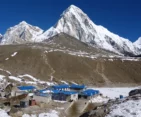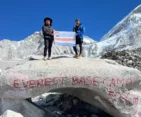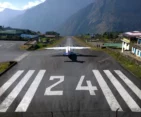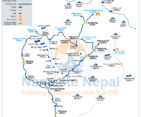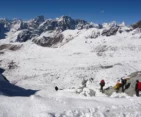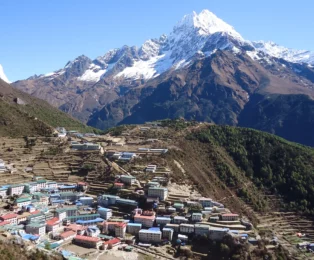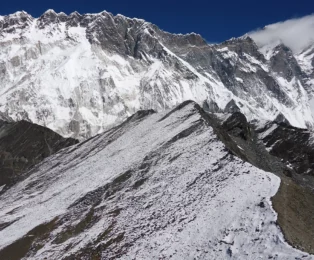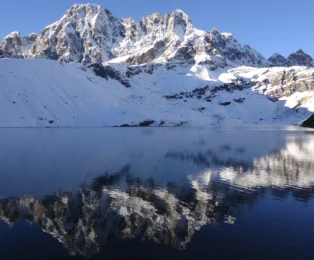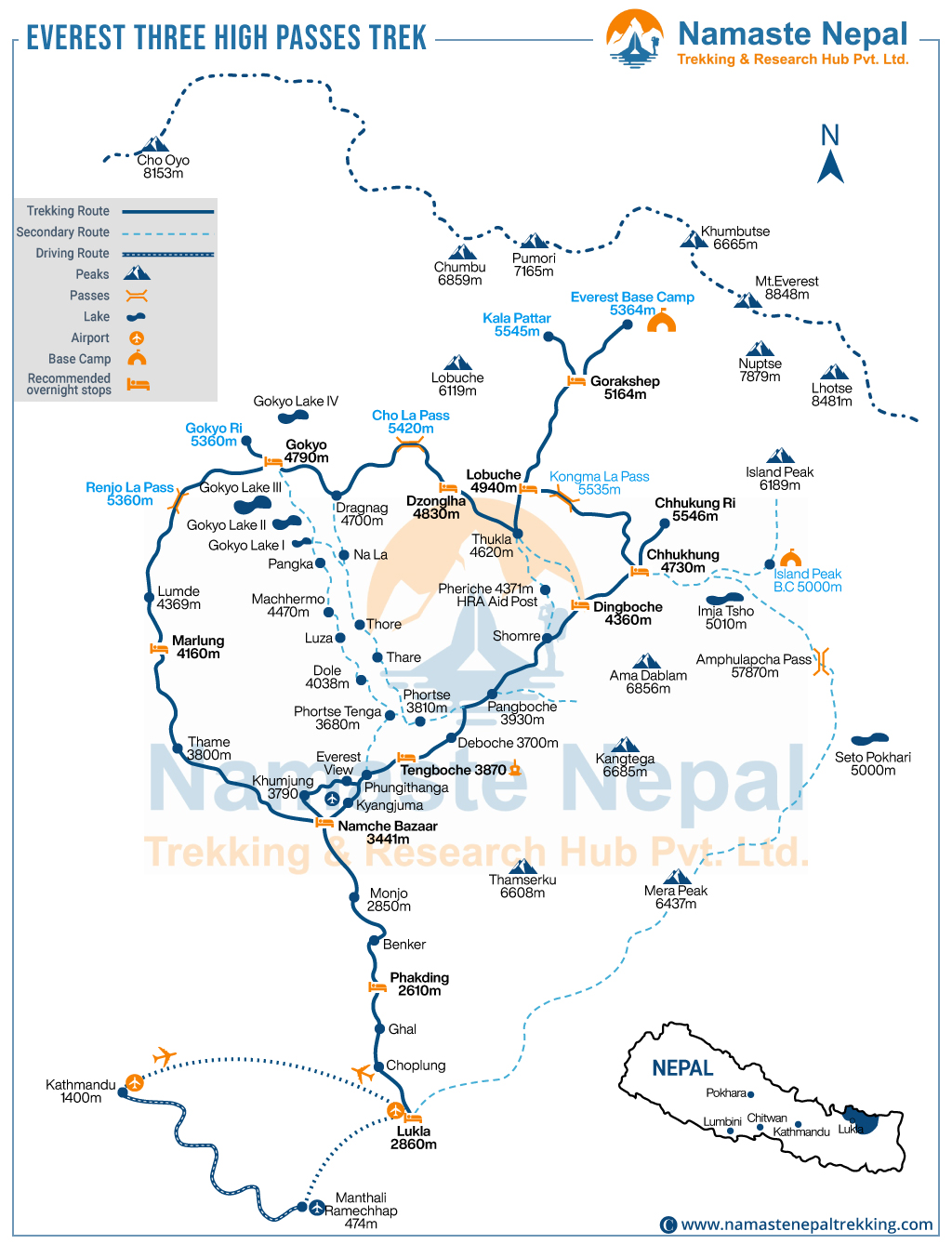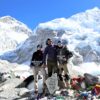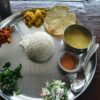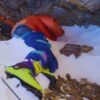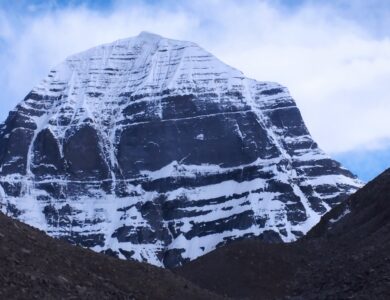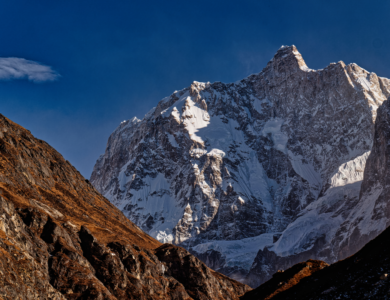Everest Three Passes Trek - 18 Days
18 Days
Difficult
5,545m / 18,192 ft (Kala Patthar)
1-15 People
Kathmandu / Kathmandu
Spring , Autumn and Early Winter
- 18 Breakfast
- 16 Lunch
- 17 Dinner
- 3-Star Hotel in Kathmandu
- Room with Attached Bathroom during the Trek
- Best available Guesthouse during the Trek
- Private Tourist Vehicle
- Lukla Flight Tickets
- 1 - 1 personUS$ 2495
- 2 - 2 personUS$ 1980
- 3 - 5 personUS$ 1765
- 6 - 10 personUS$ 1695
- 11 over 9999 US$ 1600
- Your safety, our no 1 priority
- Best price guarantee
- Experienced & dedicated team
- Easy booking, no hidden charge
- You can customize this trip
US$ 2495
Trip Overview
The Everest Three Passes Trek offers an exciting adventure in the stunning Everest region of Nepal. This trek passes through three high-altitude passes: Kongma La at an elevation of 5,535 meters, Cho La at 5,420 meters, and Renjo La at 5,360 meters. Each pass presents an awe-inspiring challenge and is a gateway to some of the most spectacular landscapes you’ll ever witness.
Throughout your journey, you’ll get to witness unparalleled panoramic views of the majestic Himalayas. You’ll also have the unique opportunity to visit Everest Base Camp, where climbers from around the world prepare for their ascent to the summit of the world’s highest peak. Another highlight of this trek is exploring the serene and strikingly beautiful Gokyo Lakes, whose turquoise waters reflect the towering snow-capped peaks around them.
Your adventure is not just about breathtaking landscapes; it’s also a cultural experience. You’ll immerse yourself in the rich traditions and warm hospitality of the Sherpa people, whose age-old culture and lifestyle beautifully complement the natural grandeur of the region.
If you’re planning to book a trek, our Team at Namaste Nepal is here to make your journey well-organized and unforgettable. With our expertise and dedication, we’ll ensure that your Everest Three High Passes Trek is a deeply rewarding experience that you’ll cherish forever.
Of course, the Everest Three High Passes Trek is demanding, with high altitudes presenting a serious challenge. However, with proper acclimatization, careful planning, and the support of our experienced guides, you will be well-prepared to tackle this once-in-a-lifetime adventure. Namaste Nepal Trekking is committed to making your trek as enjoyable and hassle-free as possible, allowing you to focus on the incredible journey ahead.
Major Highlights of Everest Base Camp Three Passes Trek
The Everest Passes Trek is a must-do adventure when visiting Nepal. It is one of the most incredible trekking experiences you can go on, offering stunning views of Mount Everest, the highest mountain in Nepal. Along the route, you’ll be treated to breathtaking sights of glaciers and pristine lakes, making every step of the trek unforgettable.
Apart from the best view of Mount Everest, the trek also provides views of other magnificent peaks such as Ama Dablam and Lhotse. This trek ingeniously connects the Everest Base Camp route with the Gokyo Valley, showcasing the beauty of the region’s natural resources that will surely leave you in awe.

As you hike, you’ll pass through small villages, home to people who have lived in these mountains for centuries. The rich cultural heritage and warm hospitality of the local inhabitants add a unique charm to your trekking experience. The blend of natural beauty and cultural richness in the Everest Three High Passes Trek makes it an adventure that’s both challenging and deeply rewarding.
Also, the Everest Base Camp Three passes trek is also known for its challenging terrain and spectacular scenery. Following are the major highlights of Everest Base Camp 3 passes Trek:
Serene Kongma La Pass (5,535 meters):
- The highest pass on the trek. Tough but worth it for the views of Makalu, Lhotse, Nuptse, and the Khumbu Glacier.
- Less crowded, offering a peaceful trek.
Icy Cho La Pass (5,420 meters):
- Connects Gokyo Valley with Khumbu Valley. The most technical part of the trek with steep and icy trails.
- Feels like walking in a frozen world with glacial lakes and ice formations.
Panoramic Renjo La Pass (5,360 meters):
- Offers amazing mountain views, including Everest behind the Gokyo Lakes.
- Less crowded, making it a peaceful end to the trio of passes.
Chukung RI (5,546 meters)
- Located in the Imja Valley, Chukung Ri is often a quieter and less crowded option compared to some of the other peaks. Nevertheless, it offers one of the most dramatic panoramic views in the Khumbu region. At the summit, you’ll be rewarded with close-up views of Lhotse, Ama Dablam, and Makalu.
- The ascent up Chukung Ri is a great day trip, especially if you’re already acclimatizing in the nearby Chukung village.
Everest Base Camp:
- Reaching it is a major achievement. Located at 5,364 meters with views of Khumbu Icefall and surrounding peaks.
- Experience Sherpa culture, traditional villages, monasteries, and local hospitality.
Kalapatthar (5,644 meters):
- Often considered the best vantage point for jaw-dropping views of Mount Everest, Kalapatthar is a bucket-list spot for many trekkers.
- The sunrise or sunset from this peak reveals Everest in all its glory, along with awe-inspiring panoramas of the Himalayas.
Gokyo Ri (5,357 meters):
- This is another iconic viewpoint in the Everest region. The trail to Gokyo Ri takes you past a series of stunning glacier lakes, offering views that are simply magical.
- From the top, you get sweeping vistas of Everest, Lhotse, Makalu, and Cho Oyu. It’s not just the peaks that will leave you speechless, but also the tranquility and beauty of the lakes nestled below you.
Gokyo Lakes:
- Stunning turquoise glacial lakes surrounded by high peaks.
- Climbing Gokyo Ri (5,357 meters) provides a 360-degree view of the Himalayas and Ngozumpa Glacier.
Sagarmatha National Park:
- A UNESCO World Heritage Site with some of the highest peaks, including Everest. Home to unique flora and fauna.
- Wildlife sightings may include Himalayan Thars, Snow Leopards, and pheasants. Lush forests contrast with icy landscapes.
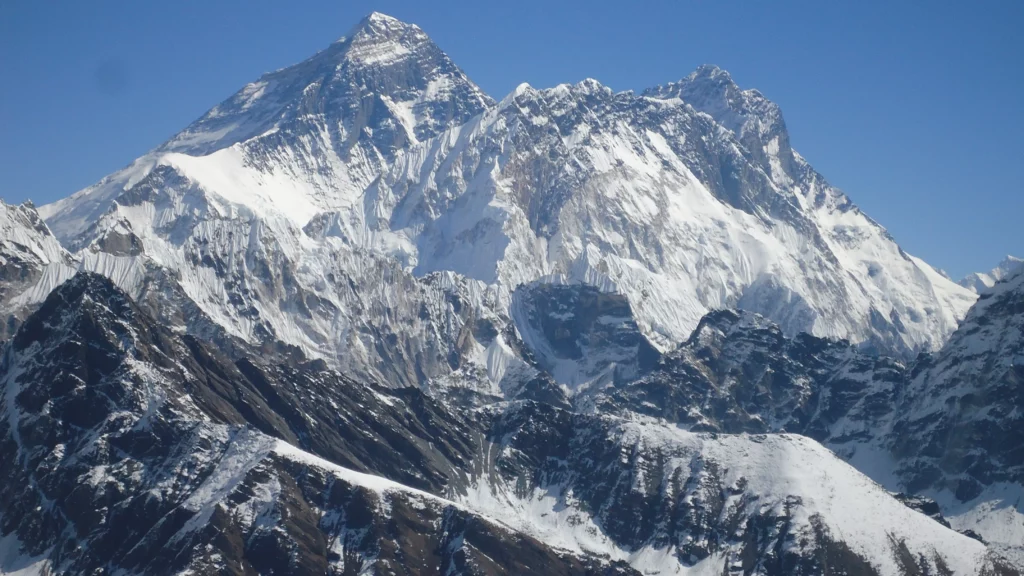
What to expect at Everest Three Pass Trek?
Your trek will start a with scenic flight from Kathmandu to Lukla that lasts about 30 to 40 minutes. This small town, which is at an altitude of 2,860 meters, is also the gateway to the Everest region and marks the starting point of your trekking journey. Here, you’ll catch your first glimpses of the local people, known for their warm hospitality and unique cultural practices. When welcoming tourists, they often present a Khada, a traditional silk scarf symbolizing respect and good luck.
The Everest Three High Passes Trek is a circular route that begins and ends in Lukla. Your first short trek will bring you to Phakding, a village situated at an altitude of 2,610 meters. This is an excellent place to acclimatize and prepare for the journey ahead.
From Phakding, the trek continues to Namche Bazaar, the heart of the Khumbu region, located at 3,440 meters. Namche Bazaar offers trekkers a chance to rest and explore local markets, cozy cafes, and the Sherpa Culture Museum, which provides a fascinating glimpse into the lives of the Sherpa people.
Your next stop will be Tangboche, home to the famous Tangboche Monastery. Here, you can find lodges offering better facilities, including hot showers and Wi-Fi. However, be prepared for the fact that the more remote areas will have more basic amenities.
As you trek, you’ll have the opportunity to enjoy the local cuisine, which includes Dal Bhat, a nutritious mix of steamed rice, lentil soup, and various spices, often accompanied by vegetables, meat, and pickles. You can also try Momos, tasty dumplings filled with vegetables or meat, usually served with pickles or soup. Thukpa, a comforting noodle soup loaded with beans, carrots, cabbage, and possibly meat, is another delicious option. Don’t miss Tsampa, a traditional food made from roasted barley flour, typically mixed with tea or milk to form a dough-like consistency.
From Tengboche, you’ll head to Dingboche at 4,410 meters. This village is perfect for acclimatization with its high altitude and beautiful views of peaks like Ama Dablam and Lhotse. While there, you can explore, take short hikes, and soak in the peaceful mountain atmosphere.
After leaving Dingboche, the trek heads to Chukhung, the last village before the first high pass. At 4,730 meters, Chukhung is your last chance to prepare and stock up on supplies. Be sure to charge your devices and check your gear, as amenities and connectivity will be limited from here on.
The first major pass you’ll face is the Kongma La Pass at 5,535 meters. It’s tough but offers stunning glacial views. After crossing, you’ll descend to the village of Lobuche at 4,940 meters, a key stop on the way to Everest Base Camp (EBC). Next, you’ll head to Gorak Shep, the last stop before EBC, sitting at 5,164 meters, with limited lodging due to its remote location. From Gorak Shep, a trek brings you to Everest Base Camp, a once-in-a-lifetime experience.
After EBC, you’ll tackle Cho La Pass at 5,420 meters, which is steep and can be icy, requiring careful navigation. You’ll then descend to the village of Gokyo at 4,800 meters, known for its beautiful lakes and milder climate, perfect for a rest.
The final major pass is Renjo La Pass at 5,360 meters, which leads you back to Namche Bazaar through Marlung, and eventually loops back to Lukla.
Overall, the Everest Three High Passes Trek is certainly a great adventure and well worth the investment with proper planning. You’ll experience the majestic Himalayas, immerse yourself in the local culture, and achieve something truly remarkable.
Is 3 Pass Trek Right for You?
Trust me, going on the Everest Three High Passes Trek may seem like a once-in-a-lifetime adventure, and it truly is! The breathtaking views, the sense of accomplishment, and the unique experience are all incredible. However, it’s important to be mindful of the different challenges you may encounter along the way. The altitude can be tough on your body, and the weather conditions can change rapidly, making the trek both physically and mentally demanding. Make sure to prepare adequately, stay aware of your surroundings, and listen to your body to ensure a safe and unforgettable journey.
The Everest Three High Passes Trek is one of the toughest treks in the Himalayas, requiring both physical and mental endurance. With thin air and low oxygen levels, altitude sickness is a real risk, causing symptoms like headaches, nausea, and dizziness. To combat this, acclimatization is crucial.
Trekkers hike 6 to 8 hours daily, so having strong legs and good cardiovascular endurance is essential. Be ready for sudden weather changes, rocky paths, snow-covered trails, and glacial moraines. The trek is mentally demanding as you deal with fatigue, discomfort, and challenging conditions. Staying motivated and focused is vital to avoid accidents and make smart decisions regarding pace and rest.
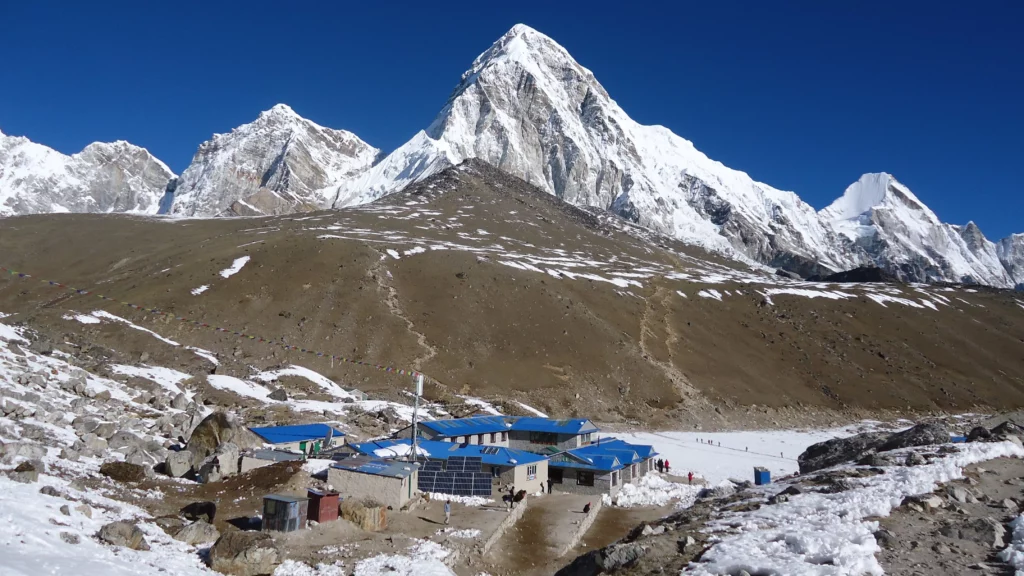
Stress from physical strain and high-altitude conditions requires you to maintain mental clarity and a positive attitude. Patience and proper acclimatization will help manage altitude effects. Overall, the trek tests your limits, so thorough preparation in physical fitness and mental readiness is key. Consider training at high altitudes and practicing mindfulness or meditation to build resilience. Proper preparation will help you fully enjoy this incredible journey through the Himalayas.
The Everest Three High Passes Trek can also be financially demanding, requiring careful budget planning to cover various expenses. Costs can include permits, gear, guided tours, flights to and from Lukla, accommodations, and meals along the way. Additionally, unexpected expenses might arise, such as health-related emergencies or the need for additional supplies. Travelers might also want to allocate funds for souvenirs or local services. It’s important to factor in all these potential costs to ensure a smooth and stress-free trekking experience through this incredible part of the Himalayas.
Let’s talk in detail about some of the demands and difficulties you’ll face along the trek.
Physical Challenges
This trek is considered one of the more challenging in the Everest region due to its high altitude and demanding terrain. Here are a few key physical challenges to be aware of:
1. Altitude Sickness: As you ascend to higher altitudes, the air becomes thinner, potentially causing altitude sickness, also known as Acute Mountain Sickness (AMS). Symptoms can range from headaches and nausea to more severe conditions like High Altitude Pulmonary Edema (HAPE) or High Altitude Cerebral Edema (HACE). It’s vital to acclimatize properly, stay hydrated, and listen to your body to avoid these issues.
2. Strenuous Hiking: The trek involves long, steep ascents and descents that can be physically demanding, even for experienced hikers. Daily treks can range from 4 to 8 hours, requiring a good level of fitness, stamina, and mental resilience. Training in advance with cardio exercises, strength training, and hiking practice will prove beneficial.
3. Weather Conditions: The weather in the Himalayas can be unpredictable. You might experience a wide range of temperatures, from warm sunny days to freezing nights. Proper gear, including thermal clothing, waterproof layers, and sleeping bags rated for low temperatures, is essential to stay comfortable and safe.
4. Remote Locations: Many sections of the trek are quite remote, with limited access to medical facilities. Carrying a well-stocked first aid kit is crucial, alongside any personal medications you may need. It’s also wise to familiarize yourself with basic first aid techniques for common trekking injuries.
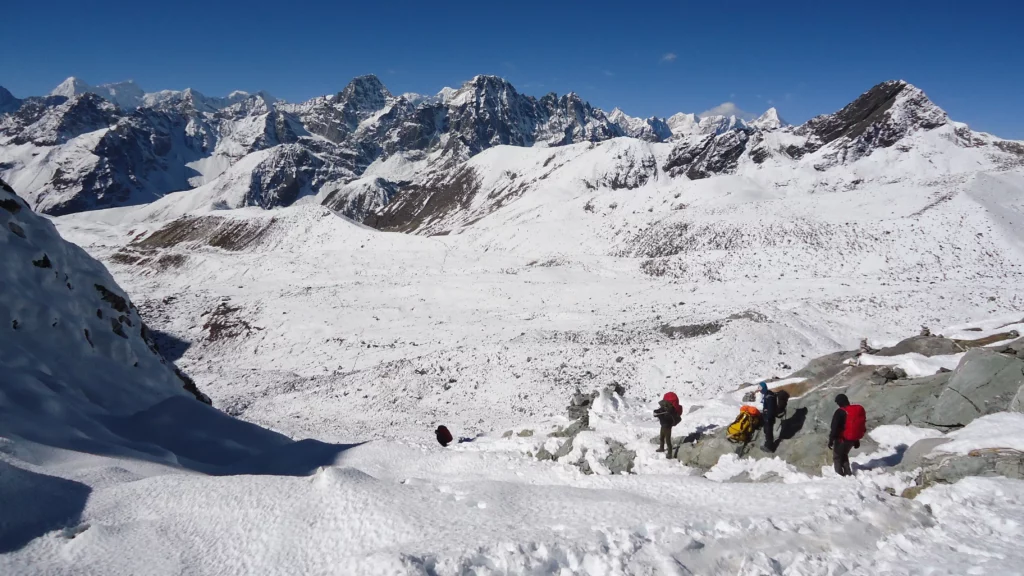
Financial Considerations
The Everest Three High Passes Trek has its costs, but it’s part of the adventure. Budget for necessary permits like the Sagarmatha National Park Permit and the TIMS card. Hiring a guide and porter can ease your experience, and quality trekking gear is essential. Accommodation and meals in tea houses are affordable but add up, especially for extras like hot showers.
When you Book with us, everything is covered, making for a safer and more enjoyable trek.
Mental Challenges
Taking on the Everest Three High Passes Trek is equally about mental endurance. You might feel isolated at times, as long stretches can be quite solitary. Homesickness can also creep in, so staying somewhat connected with loved ones might help. The constant exertion and thinning air can lead to mental fatigue, so bring lightweight distractions like a journal or a music player. Weather changes and unexpected plans require adaptability, making mental flexibility crucial.
Self-motivation is key; small goals and celebrating milestones can keep your spirits high. And adjusting to high altitudes can be tough, but knowing the symptoms of altitude sickness and taking it easy when needed will help.
How to Prepare for the Everest Three Passes Trek
Embarking on the Everest Three High Passes Trek isn’t your run-of-the-mill hiking trip. It’s a challenging adventure that requires more than just enthusiasm—you’ll need the right permits, paperwork, and preparation. Here’s a breakdown of what you need to do to get ready.
Visa for Nepal
First things first, most travelers will need a tourist visa to enter Nepal.
Upon Arrival: You can obtain a visa when you land at Tribhuvan International Airport in Kathmandu.
In Advance: Alternatively, apply for one at a Nepalese embassy or consulate before you travel.
A 30-day visa is most commonly issued, but you can also get 60 or 90-day visas if needed.
Make that your passport is valid for at least six months beyond your planned stay.
Getting a tourist visa for Nepal is an easy process. You can get it either online or upon arrival in Kathmandu.
For detailed info, check out our complete Nepal Tourist Visa Guide at:
Travel Insurance
Next up is securing the right travel insurance.
Essential Coverage
Your insurance must cover trekking at high altitudes, medical emergencies, and potential evacuations.
High Altitude Coverage:
Make sure your policy specifically mentions coverage for treks above 4,500 meters (14,763 feet). The Everest 3 High Passes Trek involves crossing high-altitude passes like Kongma La, Cho La, and Renjo La.
Emergency Evacuation
Look for a policy that includes helicopter evacuation. If something goes wrong, these services can be incredibly expensive without proper coverage.
You should definitely check out our detailed guide to Nepal travel insurance on our website. It has all the info you need to make sure you’re covered for anything that might come up during your trip. From medical emergencies to trip cancellations, we’ve got you covered. For more details check out:
Permits Required for the Everest Three High Passes Trek
Permits are essential part of your journey to explore the Everest region. Don’t worry though, we’ve got you covered. At Namaste Nepal, we’ve made getting permits super easy.
Why Do You Need Permits?
So, why do you need these permits? Well, the Everest region is a protected area with a lot of cultural and environmental importance. It has unique ecosystems and a rich heritage. Authorities require permits to manage tourism and respect local communities. These permits help control visitor numbers, preventing overcrowding and environmental damage. They also ensure trails and areas stay well-maintained, keeping the scenery beautiful for future generations.
Moreover, the permits help local communities by supporting sustainable tourism. The fees go towards improving trails, building bridges, and maintaining facilities. They also fund conservation efforts to protect local plants and animals and provide economic benefits to residents, supporting their traditional ways of life. Essentially, these permits ensure your adventure is amazing and sustainable. You’ll explore the Everest region knowing your trip helps preserve the area and benefit its people. While it might seem like an extra step, getting these permits is key to being a responsible traveler.
The Permits You’ll Need
You’ll need two main types of permits for the Everest 3 High Passes Trek: the Trekkers’ Information Management System (TIMS), Khumbu Pasang Lhamu Rural Municipality Entrance Permit Card and the Sagarmatha National Park Entry Permit.
1. Sagarmatha National Park Entry Permit
Getting this permit allows you to step into the Sagarmatha National Park, which is home to Mount Everest and listed in a UNESCO World Heritage site. With this permit, you’re not just visiting any park—you’re entering a remarkable zone of unique biodiversity and rich Sherpa culture. The park has stunning landscapes, rare wildlife, and vibrant cultural heritage. To get this permit, all you need is your passport and a photo. Pretty straightforward, right?
2. Khumbhu Pasang Lhamu Rural Municipality Entrance Permit
Don’t forget the Khumbu Pasang Lhamu Rural Municipality Entrance Permit for trekking in the Khumbu region, where some of the best parts of the Everest 3 Pass Trek are. Named after Pasang Lhamu Sherpa, the first Nepali woman to summit Mount Everest, this permit helps local communities by supporting infrastructure and conservation projects.
It’s easy to get this permit; just bring your passport and a recent photo. You can pick it up at the Khumbu region entrance in Lukla.
Having this permit, along with your TIMS Card and Sagarmatha National Park Entry Permit, you’ll be all set for an incredible trekking adventure in the Himalayas. Remember to double-check your paperwork and keep these permits safe.
3. TIMS Card
The TIMS Card acts like your personal trekker ID, which is pretty important when you’re out trekking in remote areas. It’s basically there to keep tabs on all the trekkers in the area. This record-keeping is super important for your safety, especially if something goes wrong. Think of it as having a digital guardian angel looking out for you, making sure everyone is accounted for in case of an emergency.
To obtain your TIMS Card, you’ll need to gather a few things: your passport, details of your travel insurance, and a couple of passport-sized photos. These are essential for processing your application. So, prepare these documents ahead of time to save you from any last-minute problems.
What Documents Do You Need?
To get these permits, you just need to send us a few things. Don’t worry, it’s easy, and we’ve got a checklist for you.
- Passport: A scan of the main page.
- Passport-Sized Photos: Two recent ones.
- Travel Insurance: Copy of your travel insurance that covers high-altitude trekking.
You give us the documents, and we’ll handle the rest. We’ve got this covered!
So, get your passport copies and photos ready, send them our way, and let us handle the rest. Adventure is calling, and we want to make sure nothing stands in your way—not even a mountain of paperwork.
Smooth Permits Process with Namaste Nepal Trekking & Research Hub
When you’re getting ready for a trek, the last thing you need is to stress about permits. At Namaste Nepal, we’re more than just a trekking company – we’re your adventure partners. We’ll take care of your permits quickly and accurately, so you can focus on dreaming about the amazing landscapes instead of dealing with paperwork.
Leave the permit stuff to us—it’s our job, and we love doing it! You focus on getting fit, packing right, and daydreaming about those jaw-dropping mountain views. Saving time on paperwork means more time to enjoy the Everest Three High Passes Trek.
Altitude Sickness and Proper Acclimatization for Everest 3 Pass Trek
Altitude sickness, also known as acute mountain sickness (AMS), can really ruin what’s supposed to be an amazing adventure in the mountains. It happens when your body doesn’t have enough time to get used to higher elevations and the reduced amount of oxygen up there. If you don’t get the right treatment quickly, it can actually be really dangerous and could lead to severe health problems.
To help prevent these issues, we’ve put a ton of effort into carefully planning our itineraries to make sure you have plenty of time to acclimate to the altitude. We understand just how important it is to adjust properly, so we’ve included several strategically placed pit stops and breaks throughout your trek. This way, you can take it easy, rest up, and really enjoy your journey without worrying too much about altitude sickness.
Common Symptoms:
- Headache
- Nausea and vomiting
- Dizziness or light-headedness
- Insomnia
- Fatigue
Severe Forms:
- High Altitude Pulmonary Edema (HAPE)
- High Altitude Cerebral Edema (HACE)
Both conditions are life-threatening and require immediate descent and medical attention.
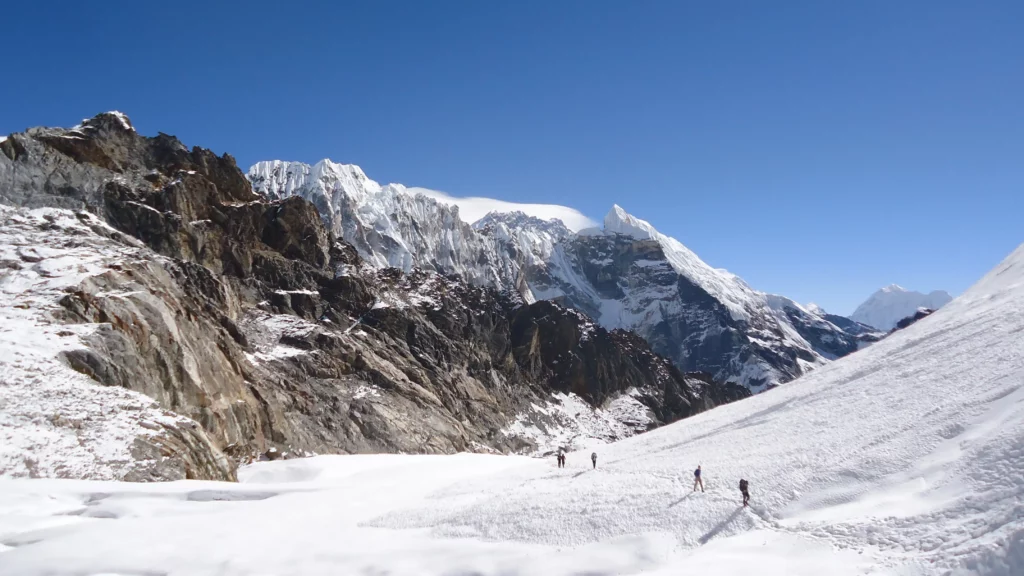
Proper Acclimatization is the key to the Successful Expedition to Everest Three Passes Trek.
Gradual Ascent: Don’t gain more than 300–500 meters (1,000–1,640 feet) in altitude per day above 3,000 meters (9,843 feet). Include rest days at higher elevations.
Hydration: Drink 3-4 liters of fluids daily. Avoid excessive alcohol and caffeine.
Nutrition: Eat a balanced diet rich in carbohydrates for energy and acclimatization.
Listen to Your Body: Monitor symptoms closely. If you feel unwell, communicate with your group and consider descending.
Physical Preparation: Engage in cardiovascular exercises before your trek. Some trekkers benefit from acclimatizing at lower elevations first.
Medications: Consult with a healthcare provider about using Acetazolamide (Diamox) to prevent and reduce the severity of altitude sickness.
By following these guidelines, you’ll be well-prepared for the incredible and challenging Everest 3 High Passes Trek.
Recommended Equipment Packing for Three Pass Trek
This basic equipment checklist is here to guide you in getting ready for your trek. Packing efficiently is key, so aim to keep your gear as lightweight as possible for a more comfortable experience. At the start of your trek, your bag should weigh no more than 44 pounds (20 kg). Staying within this limit ensures that the Porter can carry your bag with ease and helps you handle the physical challenges of the journey better. Take a moment to go through the checklist thoroughly and pack wisely to enhance your experience while avoiding unnecessary strain.
- Sun hat or scarf
- Warm fleece hat
- Sunglasses
- T-shirts
- Fleece jacket or pullover
- Fleece Wind-Stopper jacket (optional)
- Waterproof (preferably breathable fabric) shell jacket
- Down jacket
- Lightweight gloves and or
- Heavyweight gloves
- Under Garments
- Hiking shorts
- Lightweight cotton long pants
- Fleece or wool pants (seasonal)
- Waterproof pants
- Thin, lightweight inner socks
- Thick, warm wool hiking socks
- Hiking boots with spare laces
- Camp shoes (sneakers and/or sandals)
- Sleeping bag
- Headlamp
- Trekking Bags
- Duffle bags
- Basic First Aid Kit
- Regular medicine
- Trekking Poles
- Water bottles
- Camera and spare batteries
- Extra Battery/Backup
- Medium-sized quick-drying towel
- Toothbrush/Paste
- Multipurpose soap
- Deodorants
- Nail clippers
- Face and body moisturizer
- Personal Hygiene
- Wet wipes (baby wipes)
- Tissue /toilet roll
- Anti-Bacterial hands wash
- Reading book
- Trail Map/Guidebook
- Lightweight reading material or Journal with Pen
- iPod/Smartphones
- Pencils and small notebooks
- Camera and spare batteries
- Snacks and energy bars
- Gaiters (for snow or muddy trails)
- Lightweight binoculars
- Portable trekking pillow
- Traveling games (Uno, playing cards, dice, etc)
- Copies of important documents (passport, insurance)
- Cash for tea houses, tips, and small purchases
- Travel insurance details
- Emergency contact information
Layering: Dress in layers to manage temperature changes easily.
Breaking in Gear: Make sure all gear, especially boots, is not broken and comfortable before the trek.
Weight Management: Keep your backpack weight as light as possible without sacrificing essential items.
Training: Physical preparation is key; train with hikes and exercise to build endurance.
Outline Itinerary of Three Pass Trek
Arrive at Kathmandu
Trek Preparation and Sightseeing Tour of the Kathmandu valley
Fly to Lukla (2,860m / 9,383 ft) and trek to Phakding
Trek to Namche Bazar
Acclimatization and Rest day- Namche Bazar
Trek to Tengboche
Trek to Dingboche
Trek to Chukhung
Acclimatization & Rest Day at Chukhung, Climb Chukhung Ri (5,550 m / 18,208 ft)
Trek to Lobuche via Kongma La Pass (5,535 m /18,160 ft)
Trek To Everest Base Camp (5,364m / 17,599 ft) and return to Goreak Shep
Climb Kala Patthar (5,545m / 18,192 ft), then Trek Down to Dzonglha
Trek to Gokyo via Cho La Pass (5,367m/17,609 ft)
Visit Gokyo Ri (5,357m / 17,576ft), and Rest at Gokyo
Trek to Marlung via Renjo La Pass (5,360m / 17,585 ft)
Trek to Namche Bazaar
Trek Back to Lukla
Fly Back to Kathmandu
Departure Day
Why Everest Three Pass Trek is the Grandest Trek in Nepal: Insights from the Founder
Hi! I’m Rajan Lamichane, Founder, and Managing Director of Namaste Nepal Trekking & Research Hub. I grew up in a small mountain village in Gorkha. I started in the Travel and Tourism Industry as a porter and worked my way up to guide, group leader, and operation manager in a prominent trekking and tour company in Nepal. With over 15 years in the business, I eventually started my own trekking, tour, and adventure company, Namaste Nepal Trekking & Research Hub.
What a journey it’s been! Getting my guide license was a big step, but the real excitement was starting my own trekking company, Namaste Nepal. I wanted to share Nepal’s beauty and culture with everyone.
Running the business has its ups and downs, but it’s so rewarding. I meet people from all backgrounds and guide them through some of the most stunning landscapes. Every trip, whether to Everest Base Camp or touring ancient cities, offers new stories and experiences.
As the founder of Namaste Nepal Trekking, I gotta say, the Everest 3 High Passes Trek is an absolute thrill. It’s such an amazing mix of natural beauty, local culture, and physical challenge that makes you feel like you’re on top of the world, literally!
From the start, Landing in Lukla is this insane adrenaline rush—totally unforgettable. It’s like the gateway to the stunning Himalayas.
Then, trekking through villages like Namche Bazaar is incredible. Life thrives in these high-altitude spots, and Namche is especially close to my heart. It’s got this buzzing vibe, and the Sherpas’ resilience and cultural richness always blow my mind.
A favorite spot of mine is the Tengboche Monastery. With Mount Ama Dablam in the background, it’s so peaceful. Joining a morning prayer session with monks chanting is just surreal and grounding. Crossing the three passes—Kongma La, Cho La, and Renjo La—is out of this world. Kongma La, with its rocky terrains and views of glaciers and peaks, feels like another planet. The rush you get from these passes is unmatched; it’s nature at its most awesome.
Gokyo Valley is another gem, with its crystal-clear lakes that mirror the peaks. Climbing Gokyo Ri to watch the sunrise is unforgettable. Seeing Everest light up in the morning is pure magic. Kala Patthar offers the best Everest views. It’s a tough climb, but the panoramic reward is so worth it. Standing there, you really do feel on top of the world.
Every step of the Everest 3 High Passes Trek is unique, and revisiting these places always floods me with great memories. This trek isn’t just a journey; it’s a life-changing experience that opens your soul to nature’s raw beauty and power.
Why come on an Adventure with us (Team Namaste Nepal) for your Everest Three High Passes Trek?
Taking on the Everest 3 High Passes Trek is a big deal. It’s packed with amazing views, challenging heights, and unforgettable experiences. So, why go with Team Namaste Nepal for this unforgettable trip? Here’s why:
We Know Our Stuff
You wouldn’t want to start this epic quest with anyone other than an experienced crew, right? That’s where Team Namaste Nepal comes in. For years, we’ve been guiding thrill-seekers through the awe-inspiring Himalayas, and we love every second of it. Our team is a unique blend of seasoned mountaineers, local Sherpas, and passionate trekkers who eat, sleep, and breathe these majestic mountains.
We’ve hiked, climbed, and trekked these trails countless times, so we know them inside out – every twist, turn, and perfect pitstop. Our local Sherpas bring a wealth of knowledge about the terrain and culture, adding richness to the journey that goes beyond just breathtaking views. Meanwhile, our experienced mountaineers handle the tough stuff, ensuring your safety and making sure you’re well-prepared for whatever the mountains might throw your way.
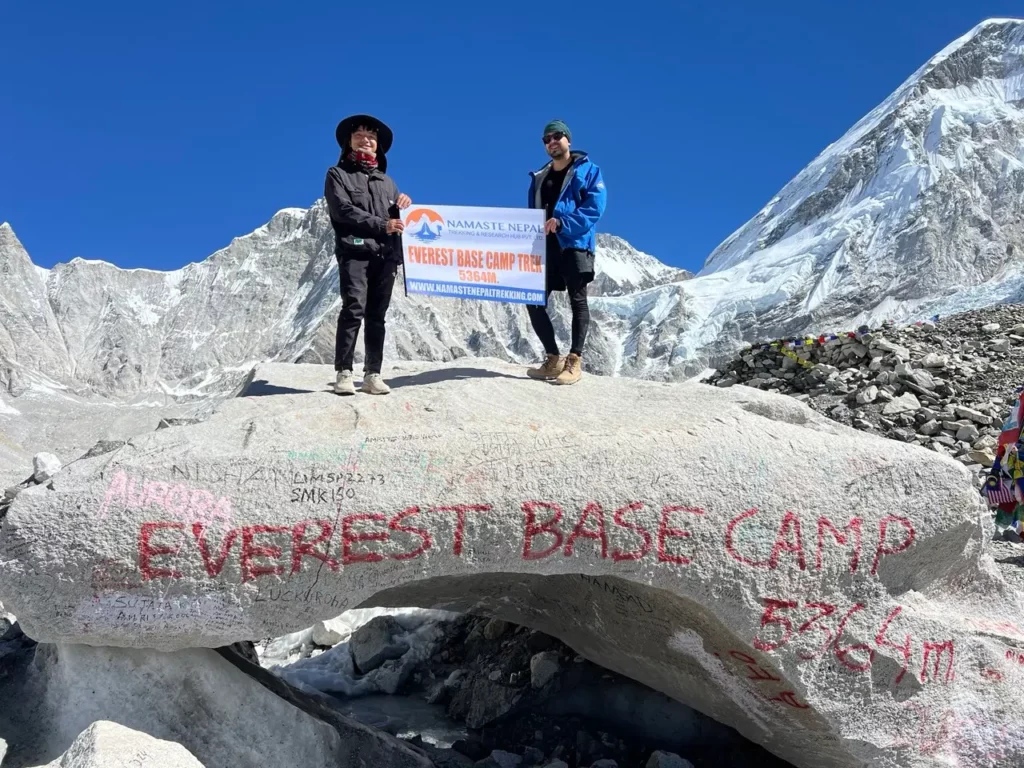
When you venture out into the Himalayas with Team Namaste Nepal, you’re not just another tourist. You’re a part of our extended family, sharing stories, laughs, and perhaps a hot cup of tea under the stars. So, lace up your hiking boots and get ready for the adventure of a lifetime with a crew that’s as passionate about these mountains as you are.
Safety First, Always
Safety is our top priority. When you’re up in the mountains, you’re dealing with everything from altitude sickness to unpredictable weather conditions. These natural elements can be really tough, so it’s crucial to be prepared. Our guides are top-notch and have been trained to handle all sorts of situations that might come up. They’re equipped with the necessary medical gear to take care of any emergencies that might arise along the way.
But we don’t stop there. Before you even start your trek, we hold comprehensive briefings to make sure you’re well-prepared. These sessions cover everything you’ll need to know, from what to pack to how to deal with altitude changes. We want to make sure you feel confident and ready to tackle the trail, knowing that you’re in safe hands the whole time.
Top-Notch Accommodation and Food
After a grueling day of trekking, there’s nothing better than good food and a comfortable place to rest your head. We partner with some of the best lodges in the region to provide you with cozy accommodations and delicious, nourishing meals. Imagine finishing a tough hike and arriving at a lodge where the staff greets you warmly, ready to serve you a meal that feels like a big comforting hug after all those miles. Think warm Dal Bhat, with its nutritious lentils and rice, perfect for replenishing your energy. Or maybe you’d prefer a steaming bowl of hot soup, soothing and packed with veggies. And for a little extra treat, there’s even some locally sourced yak cheese, rich and flavorful, to keep you fueled and happy. It’s like a little slice of home, right in the heart of your adventure.
Flexible and Personalized Itineraries
Everyone’s trekking pace and interests are different. We totally get that. That’s why we’re all about offering flexible and personalized itineraries to match your vibe. Maybe you’re someone who loves to take it slow, savoring every breathtaking view and really soaking in the experience. Or perhaps you’re the type who’s all about pushing yourself to the absolute limit, craving that exhilarating challenge. No matter your style, we’ve got you covered.
Our customized plans are designed to ensure you get the most out of your adventure, crafted to cater specifically to your preferences and fitness level. Want to take more breaks to snap photos or just enjoy the scenery? No problem. Need a hardcore journey that tests your endurance? We can do that too. Each trip is tailored to what you want, making sure your trek is as enjoyable and fulfilling as possible. Let us help you create memories that reflect your unique pace and passion for adventure.
High Customer Satisfaction
But don’t just take our word for it. Check out the reviews from our past trekkers! We’ve built lasting relationships with adventurers from around the world, many of whom return for more Himalayan escapades. The glowing testimonials highlight our commitment to providing an unforgettable experience.
Our past trekkers speak highly of the personalized service they receive from our expert guides, who bring years of experience and passion to every trek. The safety and comfort of our adventurers are our top priorities, and we go above and beyond to ensure that everyone has an incredible experience. From the nutritious and delicious meals prepared by our team to the comfortable accommodations at scenic stops, every aspect of the adventure is designed with thoughtful care.
So, why settle for ordinary when you can have an epic Himalayan adventure? Our past trekkers’ stories are filled with moments of awe and wonder, and you could be the next to share such experiences. Join us and discover the magic of the Himalayas for yourself—ask those who have wandered these trails before, and you’ll hear why they keep coming back for more.
Extras That Make a Difference
From arranging celebratory events for milestones reached on the trek to providing small comforts like hot water bottles on chilly nights, it’s the little extras that make trekking with Team Namaste Nepal special. Our commitment goes beyond the usual trekking experience; we aim to create moments that will linger long after the journey ends.
Imagine reaching a breathtaking viewpoint after a challenging day of hiking, only to find a small celebration waiting for you. Perhaps it’s a toast to your accomplishments with your fellow trekkers or a surprise treat that revives your spirit. These celebrations not only mark your progress but also enhance the camaraderie and joy of the trek.
And those chilly nights in the mountains? We’ve got you covered—literally. With hot water bottles to keep you warm and cozy, you can enjoy a good night’s rest, fully recharged for the next day’s adventure. Whether it’s a steaming cup of tea delivered to your tent in the morning or a warm blanket to snuggle into, we understand that these small comforts can make a world of difference.
But our dedication doesn’t stop there. We go the extra mile to ensure you’re not just trekking but truly savoring every moment of your journey. From dawn till dusk, we’re by your side, taking care of the details so you can fully immerse yourself in the beauty and culture of Nepal.
So, if you’re dreaming of crossing those high passes and standing in awe at Everest Base Camp, join us at Team Namaste Nepal. Admired for our personalized approach and strong support system, we promise it’ll be the adventure you’ll recount for years to come.
Photo & Video Gallery
Detailed Itinerary of Everest Three Passes Trek
Day 1: Arrive at Kathmandu
Upon your arrival in Kathmandu, a warm welcome awaits you. A representative from our company, Namaste Nepal Trekking & Research Hub will be there to greet you at the airport.
Look for the NNTR signboard outside the airport terminal where our representative will be waiting. You will then be transferred to your selected hotel where you can settle in and relax.
In the afternoon, a pre-trip meeting will take place at our office. During this meeting, you will be introduced to your trek or tour leader/guide. This is a great opportunity to ask any questions or raise any concerns you may have. For the meeting, please bring your passport, two copies of passport-sized photos, and a copy of your travel insurance policy (if you haven’t already sent it by email). You will also need to sign some paperwork, including a legally binding trip form and a non-liability disclaimer.
Activity
AriivalTrip Duration
30 MinMax Altitude
1,400m / 4,593ftAccommodation
3-Star HotelDay 2: Trek Preparation and Sightseeing Tour of the Kathmandu valley
Start Day 2 with a warm Nepali breakfast at your hotel in the morning. After that you can explore the cultural and historical gems of the Kathmandu Valley. You’ll visit UNESCO World Heritage Sites like Swayambhunath (the Monkey Temple), Pashupatinath Temple, Boudhanath Stupa, and the historic Durbar Squares of Kathmandu, Patan, or Bhaktapur, all from the comfort of a vehicle.
Your knowledgeable guide will share fascinating stories and insights about these iconic landmarks, giving you a deeper understanding of Nepal’s rich cultural tapestry. Keep your camera ready, as there will be plenty of photo opportunities, from intricate woodwork and stonework to lively market scenes.
In the afternoon, you will return to the hotel to complete the final preparations for the trek. Your guide will go over the route, safety measures, and any last-minute tips to ensure you are fully prepared for the adventure ahead. This is also the time to double-check your gear and make any necessary adjustments.
The evening offers some leisure time to either relax or further explore the vibrant streets of Thamel, Kathmandu’s bustling tourist hub. Feel free to shop for some last-minute essentials or souvenirs. You might also want to try a traditional Nepali dinner in one of the local restaurants; it’s a delicious way to end the day while immersing yourself in the local culture.
Make sure to get plenty of rest tonight, as tomorrow marks the beginning of your trekking adventure!
Activity
Preparation and SightseeingTrip Duration
5-6 HoursMax Altitude
1,400m / 4,593ftMeals
BreakfastAccommodation
3-Star HotelDay 3: Fly to Lukla (2,860m / 9,383 ft) and trek to Phakding
Your adventure starts with a morning flight from Kathmandu to Lukla, the gateway to the Everest region. This 30-minute flight is thrilling, with stunning views of Nepal’s mountains, including Everest. As you fly over green hills, deep valleys, and terraced fields, the excitement builds. Landing on Lukla’s narrow runway adds to the adventure.
Once in Lukla, you begin your trek towards Phakding. The trail descends through the scenic Dudh Koshi Valley, beside the sparkling Dudh Koshi River, with lush landscapes and cultural encounters. You’ll pass picturesque stone villages where Sherpas live their daily lives, adorned with traditional houses, prayer flags, and terraced fields, along with friendly locals and fellow trekkers.
As you walk, the snow-capped mountains provide a stunning backdrop. By the end of the day, you’ll reach Phakding, a peaceful village by the Dudh Koshi River, perfect for rest after your trek. With the river’s gentle hum and towering peaks around, your first night in the Himalayas will be peaceful and memorable.
Activity
Fly to Lukla and Trek BegainTrip Duration
3-4 HoursMax Altitude
2,610m / 8,563ftMeals
Breakfast, Lunch & DinnerAccommodation
Geusthouse with attached BathroomDay 4: Trek to Namche Bazar
After morning breakfast in Phakding, you’ll start your trek to Namche Bazaar. The path follows the Dudh Koshi River, taking you over several steel suspension bridges decorated with colorful prayer flags. Keep a lookout for yaks and other local wildlife along the way.
You will then enter Sagarmatha National Park, a UNESCO-listed site, known for its stunning biodiversity. Here, you’ll have your trekking permits checked at a checkpoint in Monjo before starting a steep ascent toward Namche Bazaar. On a clear day, you might catch your first glimpse of Mount Everest in the distance. The climb along the trek is tough but totally worth it.
When you get to Namche Bazaar, you can spend the rest of the day relaxing and exploring. This lively village is the main trading center in the Khumbu region. It used to be where Hindu traders from the lowlands and Tibetan yak caravans met. Now, it’s a cultural mix with shops, cafes, and even an Irish pub. It perfectly blends modern comforts with traditional charm.
As you settle in for the night in Namche Bazaar, you can reflect on the day’s journey and look forward to the upcoming adventures in the heart of the Himalayas.
Rest well, as the trek continues to promise more incredible experiences ahead. Feel free to explore the local markets for souvenirs or any additional gear you may need. Namche Bazaar has a variety of shops where you can find trekking gears, local handicrafts, and authentic Nepali foods.
Activity
TrekkingTrip Duration
5-6 HoursMax Altitude
3,441m / 11,289ftMeals
Breakfast, Lunch & DinnerAccommodation
Geusthouse with attached BathroomDay 5: Acclimatization and Rest day- Namche Bazar
After yesterday’s significant gain in altitude, today is dedicated to rest and acclimatization. Namche Bazaar, the tourist capital and the largest settlement in the Khumbu region offers a well-rounded experience with its ATMs, internet cafes, restaurants, bakeries, and numerous branded and local shops selling daily necessities.
Though it’s a rest day to aid in acclimatization, there are a few light activities planned to help your body adjust to the altitude. The day begins with a scenic walk up to Khumjung Village, passing through the renowned Everest View Hotel. From here, you can see the stunning views of the Himalayas, including Mount Everest.
Khumjung Village, is a vibrant little town, which is inhabited by the Sherpa community. Walking through this Sherpa village offers a unique opportunity to immerse yourself in the local culture and understand their way of life. Exploring the diverse traditions and friendly interactions will provide rich cultural insights.
Why Acclimatization is Important?
Acclimatization is essential because it gives your body the time it needs to adapt to continuous elevation gain and the reduced oxygen levels you encounter at higher altitudes. This process is important for preventing altitude sickness, which can cause symptoms like headaches, nausea, and fatigue, and in severe cases, can be life-threatening.
By allowing your body to gradually adjust, you’re setting yourself up for a safer trek, allowing you to fully appreciate the stunning landscapes and enjoy your adventure without the discomfort of altitude-related health issues. Proper acclimatization maximizes your chances of having a memorable and enjoyable experience in the mountains.
Things You Can Do in Namche Bazaar
While acclimatizing is necessary, there are plenty of other activities to keep you entertained and engaged in Namche Bazaar. This charming mountain town offers a unique blend of culture, adventure, and relaxation. Here are few options:
- Visit the Sherpa Museum for cultural insights.
- Explore local shops for souvenirs and trekking gear.
- Try yak cheese and traditional Sherpa dishes at local restaurants.
- Enjoy a cup of coffee at one of the cozy bakeries.
- Take a short hike to the Syangboche Airstrip for an elevated view of the region.
- Attend a talk on altitude acclimatization at the Sagarmatha National Park Visitor Center.
- Relax and rejuvenate with a spa or massage session.
Activity
Acclimatization and RestTrip Duration
4-5 HoursMax Altitude
3,441m / 11,289ftMeals
Breakfast, Lunch & DinnerAccommodation
Geusthouse with attached BathroomDay 6: Trek to Tengboche
After acclimatizing in Namche Bazaar, you are now ready to continue our journey deeper into the heart of the Himalayas. Today, our trek will take us from Namche Bazaar to the beautiful village of Tengboche.
Leaving Namche Bazaar at 3,440 meters (11,286 feet), you’ll follow a scenic path high above the Dudh Koshi River. The beginning of our trek features stunning mountain views, including peaks of the Himalayas. The path varies with some short ups and downs before flattening out. Along the way, we can stop at charming tea shops to enjoy Nepali Chiya (tea) and admire the beauty of Ama Dablam.
Eventually, the trail descends steeply to a suspension bridge across the Dudh Koshi River, leading us to Phunki Tenga at 3,250 meters (10,662 feet), where we’ll break for a hearty mountain lunch.
After leaving Phunki Tenga, you’ll face a steep climb through rhododendron forests with high-altitude views. This area is rich in birdlife, so look out for colorful species. Though the climb is tough, the scenery is rewarding. You’ll reach Tengboche at 3,870 meters (12,697 feet), home to the renowned Tengboche Monastery, a significant cultural and spiritual site for the Sherpa people. Tengboche offers breathtaking views of Everest, Nuptse, Lhotse, and Ama Dablam.
Tonight, you’ll stay at a Guesthouse in Tengboche next to Monastery. It’s a great chance to relax and soak in the tranquility. The clear night skies offer stunning star views, and the monastery’s evening chants provide a peaceful end to our exciting day.
Activity
TrekkingTrip Duration
4-5 HoursMax Altitude
3,870m / 12,697ftMeals
Breakfast, Lunch & DinnerAccommodation
GeusthouseDay 7: Trek to Dingboche
Waking up in the peaceful village of Tengboche, you’ll head toward Dingboche, an important stop to help you adjust to the altitude on your way to Everest Base Camp. The trail starts with a downhill walk through forests filled with rhododendron, oak, and pine trees. Along the way, you might see yaks and various birds. You’ll pass through the village of Deboche and follow the Imja Khola (river).
After passing through Deboche, you’ll cross a sturdy suspension bridge. The trail then climbs gently, passing through small settlements like Pangboche, where you can visit Pangboche Monastery – the oldest in the Khumbu region.
As you continue your trek, you’ll enter alpine terrain with fewer trees and more open spaces, offering stunning views of Mount Everest, Lhotse, and Ama Dablam. The trail gently ascends to the charming village of Dingboche, known as the “Summer Valley” because it’s relatively warmer with sunlit terraces. At an elevation of 4,360 meters (14,305 feet), you’ll settle into a local teahouse.
In the evening, take a stroll around the village, admire the stone walls protecting crops like barley, potatoes, and buckwheat, and enjoy the breathtaking mountain views. Spend the night here with a warm meal and the serene mountain atmosphere.
Activity
TrekkingTrip Duration
5-6 HoursMax Altitude
4,360m / 14,304ftMeals
Breakfast, Lunch & DinnerAccommodation
Geusthouse with attached BathroomDay 8: Trek to Chukhung
Today’s trek from Dingboche to Chukhung is short but important for acclimatization. After breakfast, you’ll take a gradual, steady path through beautiful fields and stone-walled pastures. You’ll cross streams and small bridges as you get closer to the towering Island Peak.
As you climb, the landscape becomes more rugged and stunning. Each step offers breathtaking mountain views, including peaks like Lhotse and Ama Dablam. It’s a heaven for photographers and nature enthusiasts, with every turn revealing a new, awe-inspiring scene. You’ll pass through yak pastures, where these animals graze quietly, adding local charm to the journey.
The air is alive with natural sounds, from rustling leaves to birds calling. Sometimes, you’ll see expedition groups setting up camp, adding a lively buzz to your trek. This isn’t just a hike; it’s an experience that connects you deeply with the mountains.
Upon arrival in Chukhung, a small settlement tucked away near the base of formidable glaciers, you’ll have a chance to relax and take in the pristine surroundings. The altitude here is higher than previous stops, so take it easy and drink plenty of water.
Spend the night in a cozy teahouse in Chukhung. Enjoy the serenity of the high Himalayas as you marvel at the sheer beauty around you. The day’s shorter trek allows you to rest and prepare for upcoming more challenging days.
Activity
TrekkingTrip Duration
4-5 HoursMax Altitude
4,730m / 15,518ftMeals
Breakfast, Lunch & DinnerAccommodation
GuesthouseDay 9: Acclimatization & Rest Day at Chukhung, Climb Chukhung Ri (5,550 m / 18,208 ft)
Today is all about acclimatizing, and helping your body get used to the high altitude for the tough days ahead. After a hearty breakfast at your cozy teahouse, you can take a side trip to Chukhung Ri (5,550 m / 18,208 ft). It’s a great acclimatization hike with some of the best panoramic views in the area.
Climbing Chukhung Ri gives you a fantastic sense of accomplishment and offers stunning 360-degree views of nearby peaks. After enjoying the sights, you’ll head back down to Chukhung. The round trip usually takes 4-5 hours. In the afternoon, relax at the teahouse. Stay hydrated and enjoy the beautiful Himalayan surroundings or take some time to relax and enjoy the peace of this high-altitude retreat.
Staying overnight at Chukhung, located at 4,730 meters (15,518 feet), offers a memorable experience. This village in Nepal’s beautiful Khumbu region is surrounded by stunning peaks and glaciers. As night falls, the cool mountain air and starry skies make for a magical setting. It’s an ideal place to relax, recharge, and enjoy the natural beauty, whether you’re a trekker or just looking for some peace and inspiration in the majestic Himalayas.
Activity
Climb Chukhung RiTrip Duration
4-5 HoursMax Altitude
5,546m / 18,196ftMeals
Breakfast, Lunch & DinnerAccommodation
GeusthouseDay 10: Trek to Lobuche via Kongma La Pass (5,535 m /18,160 ft)
Today is an exciting day of the Everest Three Passes Trek as we cross the Kongma La Pass, the highest of the three passes. You’ll start early to use the daylight and good weather.
After breakfast, you’ll begin climbing. The trail is rugged and remote, showcasing the Khumbu region’s raw beauty. The climb is steep and tough, but the views of towering peaks make it worthwhile.
At the top of Kongma La Pass (5,535 m / 18,160 ft), you’re rewarded with stunning views of Makalu, Lhotse, Nuptse, and Island Peak. Standing at this altitude is both thrilling and humbling. Take time to enjoy the scenery and take some photos. The pass is the highest in the Everest region, offering heavenly views of over 20 peaks, including Ama Dablam and Cho Oyu.
After a taking some break at the top, you’ll head north, eventually encountering the massive Khumbu Glacier. It will take about 2 hours to cross this tiring stretch before reaching the village of Lobuche. In Lobuche (4,940 m / 16,208 ft), find your teahouse for the night.
Despite the physical demands of the day, the breathtaking landscapes and experiences make it very rewarding. Relax, drink plenty of water, and reflect on the incredible journey so far.
Activity
Cross Kongma La PassTrip Duration
7-9 HoursMax Altitude
5,535m / 18,159ftMeals
Breakfast, Lunch & DinnerAccommodation
GeusthouseDay 11: Trek To Everest Base Camp (5,364m / 17,599 ft) and return to Goreak Shep
After early morning breakfast, we’ll head out towards Everest Base Camp (EBC), one of the most exciting parts of the Everest Three Passes. Feel the excitement build as you get closer to the base of the world’s tallest mountain.
The trail begins through rocky areas alongside the impressive Khumbu Glacier. As you approach Gorak Shep, expect stunning views of the Himalayan peaks. Rest a bit in Gorak Shep, leave your heavy gear at the teahouse, and take only essential items to Everest Base Camp. At 5,364 meters (17,599 ft), you’ll be surrounded by panoramic views of the Himalayas and climbers preparing for their ascent to the Top of the World.
After enjoying the stunning views and unique atmosphere at the Everest base camp, it’s time to head back to Gorak Shep for the evening. As you walk, you’ll feel proud of your achievement in reaching the Everest base camp, a satisfying reminder of your progress.
Once in Gorak Shep, you can rest and recharge for another exciting day of trekking. You’ll stay overnight in a local teahouse, situated at an elevation of 5,164 meters (16,942 feet). The facilities are basic with limited amenities, but they provide a warm and cozy place to relax.
Activity
Reach Everest Base CampTrip Duration
6-7 HoursMax Altitude
5,364m / 17,598ftMeals
Breakfast, Lunch & DinnerAccommodation
GuesthouseDay 12: Climb Kala Patthar (5,545m / 18,192 ft), then Trek Down to Dzonglha
Today we’ll get up early to climb Kala Patthar for stunning views of Everest at sunrise. Although the ascent is steep, it’s worth it. At 5,545 meters (18,192 ft), you’ll enjoy a panoramic view of Mount Everest and neighboring peaks like Lhotse, Nuptse, and Pumori. After taking in the scenery and snapping some photos, return to Gorak Shep for breakfast.
From Lobuche, the trail to Dzongla goes downhill with the Khumbu Glacier on the right. It’s mostly downhill with some short climbs. You’ll see the Ama Dablam peak in the southeast and the Tabuche and Cholotse peaks on the left. After crossing the Cholatse Lake and stream, it’s a short ascent to Dzongla.
Once in Dzongla, take a break to enjoy the natural beauty. The simple teahouse offers a cozy spot for a warm meal and a chance to chat with other trekkers. As evening comes, watch the peaks turn golden for an unforgettable view.
Rest well after your day’s adventure. Dzonglha is a calm place to relax. Stay hydrated, have a good meal, and get some good sleep. Tomorrow brings more stunning views and exciting trails in the Everest region.
Activity
Climb Kala PattharTrip Duration
6-7 HoursMax Altitude
5,545m / 18,192ftMeals
Breakfast, Lunch & DinnerAccommodation
GeusthouseDay 13: Trek to Gokyo via Cho La Pass (5,367m/17,609 ft)
Today’s journey promises adventure at every turn as we cross the renowned Cho La Pass, another highest and most memorable pass you’ll encounter.
After breakfast in Dzongla, get ready for a day that’s equally rewarding and challenging. Our trek begins with a gradual climb, which quickly turns steep as we approach Cho La Pass. The path may be icy and rocky, so take your time and watch your step. Along the way, you’ll be surrounded by awe-inspiring views of the Everest region, with magnificent peaks and glaciers dotting the landscape.
Reaching the top of Cho La Pass (5,367 meters or 17,609 ft) is a celebration moment. The view is breathtaking, offering a full look of Himalayan peaks like Cholatse and Lobuche. Take some time to enjoy, snap photos, and then prepare for the tricky descent to Thagnak with its loose rocks and snowy paths.
Once in Thagnak, relax with a snack and hot tea at a local teahouse. Next, we’ll cross the Ngozumpa Glacier, Nepal’s longest glacier, and take in the stunning landscapes. The final climb to Gokyo is steady, but the sight of the beautiful Gokyo Lakes makes it all worthwhile. This charming village, nestled by turquoise lakes and surrounded by snow-capped mountains, is the perfect place to relax.
At Gokyo, explore the village or enjoy a peaceful walk around the lakes. In the evening, share stories over dinner with fellow trekkers and rest well after conquering a challenging and beautiful part of your trek.
Tomorrow promises more amazing views and unforgettable experiences in the Everest region. Stay warm, stay hydrated, and get some rest for the exciting days ahead!
Activity
Cross Cho La PassTrip Duration
7-9 HoursMax Altitude
5,367m / 17,608ftMeals
Breakfast, Lunch & DinnerAccommodation
GuesthouseDay 14: Visit Gokyo Ri (5,357m / 17,576ft), and Rest at Gokyo
Today presents a perfect opportunity to visit Gokyo Ri and take some time to relax in Gokyo. We start early on our journey to Gokyo Ri, which stands tall at 5,357 meters (17,576 feet) above the village.
The ascent is quite steep and takes about three to four hours of strenuous effort. However, the breathtaking views that await at the summit make every step worthwhile. Gokyo Ri is renowned as one of the best spots in the Everest region for unparalleled mountain views.
From the top, you’ll be amazed by the beautiful view of Gokyo Village and the Nogzumpa Glacier. You can see four of the world’s highest peaks: Mt. Everest, Mt. Lhotse, Mt. Makalu, and Cho Oyu. Being near these massive mountains is absolutely breathtaking!
After enjoying the views at Gokyo Ri, we’ll head back to the valley for a hearty breakfast at our lodge. Post-meal, we’ll explore the valley, soaking in the peaceful beauty of the Himalayas.
To wrap up our day, we’ll treat ourselves to a coffee shot at the world’s highest bakery—a perfect way to reflect on our adventures with a sweet treat in this stunning setting.
Activity
Visit Gokyo RiTrip Duration
5-6 HoursMax Altitude
5,357m / 17,575ftMeals
Breakfast, Lunch & DinnerAccommodation
GeusthouseDay 15: Trek to Marlung via Renjo La Pass (5,360m / 17,585 ft)
Waking up in Gokyo feels like opening your eyes in heaven. After a warm breakfast, we start our trek towards Renjo La Pass. The trail starts off gently along the Gokyo Lake but gets steeper as we approach the pass. Though challenging, the climb rewards us with stunning panoramic views of the Himalayas, featuring peaks like Everest, Lhotse, and Makalu.
At Renjo La Pass, 5,360 meters (17,585 ft) high, take some time to enjoy the stunning views. You’ll see distant ice fields and the sparkling Gokyo Lakes below. Tibetan prayer flags flutter in the wind, adding spirituality to the rugged landscape. After taking in the sights and snapping some photos, we start our descent to Marlung.
The path is rocky and steep in parts, so take it slow. We’ll pass yak pastures and small Sherpa villages, offering a glimpse of traditional high-altitude life. Keep an eye out for wildlife like the Himalayan Tahr and colorful pheasants along the way.
We arrive in Marlung by late afternoon, where a cozy teahouse awaits with hot meals and warm drinks. This quaint village at an elevation of 4,160 meters (13,648 ft) is an excellent place to unwind after a challenging day.
Enjoy the tranquility of the surroundings and perhaps share your day’s adventures with fellow trekkers over dinner. A good night’s rest will recharge you for another exciting day on the trail.
Activity
Cross Renjo La PassTrip Duration
6-8 HoursMax Altitude
5,360m / 17,585ftMeals
Breakfast, Lunch & DinnerAccommodation
GeusthouseDay 16: Trek to Namche Bazaar
Today’s route takes us from Marlung down to the lively Namche Bazaar. Start with early breakfast, pack your gear, and get going. The first part of the trail to Thame village is fairly easy and offers beautiful views of valleys and mountains, giving our day a scenic start.
Starting from Marlung, the trail is quite easy, going downhill with only a few ascends. As we make our way, the path largely follows the scenic Bhote Koshi river, offering stunning views of the majestic Shar and Nup mountains straight ahead. Not long into our journey, we will arrive at the charming village of Thame.
Starting from Thame, our trek will take us through beautiful villages like Samde, Thamo, and Phurte. We’ll see stunning views of peaks like Thyangmoche, Lhov, Sar, and Nup to the southwest, and Thamserku, Kusur Kangru, and Kyanshar mountains to the southeast. Every step will offer a new breathtaking sight, making this trek truly unforgettable.
Reaching Namche Bazaar feels like returning to civilization. At 3,440 meters (11,286 ft), this bustling town is known as the “Gateway to Everest.” You’ll find small shops, cafes, internet spots, and warm teahouses here. Spend the evening exploring the market or relaxing in a cozy bakery with a hot drink. Share your experiences with fellow trekkers and enjoy the vibrant atmosphere.
Tonight, get some well-deserved rest in Namche Bazaar as you prepare for the final days of our amazing trek in the Khumbu region.
Activity
TrekkingTrip Duration
5-6 HoursMax Altitude
3,440m / 11,286ftMeals
Breakfast, Lunch & DinnerAccommodation
Geusthouse with attached BathroomDay 17: Trek Back to Lukla
Your last day of trekking starts with an early breakfast at Namche Bazaar. After packing your gear and enjoying the final views of this lively town, you’ll begin your descent back to Lukla. The trail follows the Dudhi Koshi River, leading you back to Lukla and marking the end of your Himalayan adventure.
As you head down from Namche, you’ll pass through the charming villages of Phakding and Monjo. These peaceful spots are great for reflecting on your journey and chatting with fellow trekkers.
The trail winds through lush forests and terraced fields, creating a serene backdrop for your final trek. Don’t forget to glance back and enjoy the majestic mountain views one last time. The sound of the Dudh Koshi River will be a soothing companion.
Suspension bridges along the way will remind you of your initial ascent, creating a beautiful full-circle moment. Once in Lukla, take a moment to enjoy the fresh mountain air before heading to your teahouse.
In the evening, celebrate with your trekking group and guides. Savor local treats like chang, a home-brewed rice beer, and maybe learn a traditional Sherpa dance. Share stories, laughter, and gratitude as you look back on the incredible experiences and friendships you’ve formed.
Spend your last night in Lukla feeling accomplished and happy. Tomorrow, you’ll fly back, leaving the trails but keeping the spirit of the Himalayas with you.
Activity
TrekkingTrip Duration
5-6 HoursMax Altitude
2,860m / 9,383ftMeals
Breakfast, Lunch & DinnerAccommodation
Geusthouse with attached BathroomDay 18: Fly Back to Kathmandu
Start your day early with breakfast at your teahouse in Lukla. As the morning mist begins to lift, you’ll make your way to the Lukla airport for your short but scenic flight back to Kathmandu. Be sure to have your camera ready to capture the stunning aerial views of the Himalayas one last time.
Upon arrival in Kathmandu, you’ll be transferred to your hotel. The rest of the day is free for you to explore the capital city, relax, or get a well-earned massage. If you’re interested in extending your adventure, we offer several exciting options:
1. Cultural Tours:
- Kathmandu Valley Sightseeing: Visit UNESCO sites like
- Swayambhunath (Monkey Temple), Boudhanath Stupa,
- Pashupatinath Temple, and Durbar Square.
- Bhaktapur and Patan Day Tour: Explore ancient cities with rich history, beautiful temples, and traditional craftsmanship.
2. Additional Treks:
3. Adventure Activities:
- White-water rafting
- Paragliding in Pokhara
- Mountain flight to Everest
4. Relax and Rejuvenate:
- Spa and wellness treatments
- Traditional Nepali massage
- Meditation and Yoga classes
Let us know if you want to add any activities to your itinerary. Enjoy your evening in Kathmandu. You can try Nepali cuisine, shop for souvenirs in Thamel, or just relax and reflect on your trip.
Activity
Fly back to KathmanduTrip Duration
35 minMax Altitude
1,400m / 4,593ftMeals
Breakfast, Lunch & DinnerAccommodation
3-Star HotelDay 19: Departure Day
The final day of your adventure has arrived. Depending on your flight schedule, you might have some free time in the morning for last-minute shopping or a leisurely stroll through the city.
You will then be transferred to Tribhuvan International Airport for your departure. As you head home, carry the memories of your trek, the beauty of the Himalayas, and the warmth of the Nepalese people with you.
Safe travels and we hope to see you again for another adventure!
Activity
DepartureTrip Duration
30 minMax Altitude
1,399m / 4,590ftMeals
BreakfastBuild Your Own Adventure!
Collaborate with our specialists to create a unique itinerary.
Three Pass Trek Cost: Find what's Inclide and what's Exclude
- All Airport hotel transfers by private vehicle
- 3-night 3-star Hotel in Kathmandu with breakfast
- Kathmandu – Lukla Flight Tickets
- OR Manthali to Lukla Flight Tickets with private transportation to Manthali
- Lukla Kathmandu Flight Tickets
- OR Lukla to Manthali Flight Tickets with private transportation to Kathmandu
- All the twin-sharing accommodations during the trek
- All the meals (Breakfast, tea break, lunch, and dinner) will be served with seasonal fruits during the trek.
- The farewell dinner in Kathmandu
- All necessary paperwork and permits
Sagarmatha National Park Permit
Khumbu Pasang Lhamu Rural Municipality Entrance Permit
Trekkers’ Information Management System - All government and local taxes
- An experienced English-speaking Trekking Guide
- Assistant Trekking guide (1 assistant trekking guide for every 10 trekkers )
- Sherpa porters (1 porter for every 2 trekkers)
- All Staff salary, insurance, equipment, transportation, food, and lodging
- Nepal visa fee ( lowest fee available is for a 15-day visa costing 30$/person)
- International airfare to and from Kathmandu
- Excess luggage charges
- Extra night accommodating in Kathmandu (if in the case early return from the mountain then the scheduled itinerary)
- Travel and rescue insurance
- Personal expenses (phone calls, laundry, bar bills, personal drinks, battery charge, bottle or boiling water, hot shower, wifi and or internet, etc)
Tips for guides and porters
Book Three Pass Trek today and enjoy the following Complimentary Services with Your Trip
- Online Pre-Trip Briefing after booking confirmation
- Free excess luggage storage facilities at our office store
- Namaste Nepal’s duffle bag
- Namaste Nepal’s T-shirt
- Trekking map
- Down jacket and seasonal sleeping bag (to be returned after completion of the trip)
- Trekking Pools (to be returned after completion of the trip).
- A self-sufficient medical first aid kit containing vital medications.
- Oximeter to check your pulse oxygen saturation and heart rate twice daily (Very useful to check AMS symptoms)
Addons & Options for Everest Three Passes Trek
Addons
Price
Kathmandu to Lukla by Sharing Helicopter
US$ 400
Lukla to Kathmandu by Sharing Helicopter
US$ 400
Everest Three Passes Trek - 18 Days Altitude Chart
Additional Information About Everest Three Pass Trek
Transportation Options for Everest Three High Passes Trek
When prepping for the Everest Three Pass Trek, one crucial piece of the puzzle is figuring out how you’re actually going to get there. It’s not like you can just Uber your way to Everest. Let’s talk about the different transportation options you have, focusing particularly on the Lukla Flight from Manthali Airport, plus a few alternative travel methods that might come in handy.
The Famous Lukla Flight: Direct Flight from Kathmandu or Manthali Airport?
Flying into Lukla is a popular way to start your Everest adventure. Lukla’s Tenzing-Hillary Airport sits at 2,860 meters (9,383 feet) with a short runway making for thrilling takeoffs and landings. In the Low Season (December, January February, Jun, July, August, and September), flights depart from Tribhuvan International Airport in Kathmandu, but in the high season (March, April, May, October, and November) they usually leave from Manthali Airport in Ramechhap District. The Flight route and operating dates to Lukla might change, Please Get in touch with us to know which route you will be taking to reach Lukla.
Flying from Manthali to Lukla
You can reach Manthali with a 4-5 hour, 132-kilometer (82 miles) drive from Kathmandu. The flight to Lukla lasts about 20-25 minutes from Manthali and offers incredible mountain views. The blend of excitement and nerves is common as the small aircraft ascends, providing stunning vistas of the Himalayan peaks. Approaching Lukla, the plane descends onto one of the world’s most thrilling runways, with expert pilots making the experience safe yet exhilarating.
Weather is a major factor, and flight delays are common. Adding buffer days to your schedule is wise to accommodate potential changes. The unpredictable weather in the Himalayas can lead to delays or cancellations, so having a flexible itinerary can save stress. Consider extra time for trekking or exploring Kathmandu and its surroundings, which also helps with acclimatization.
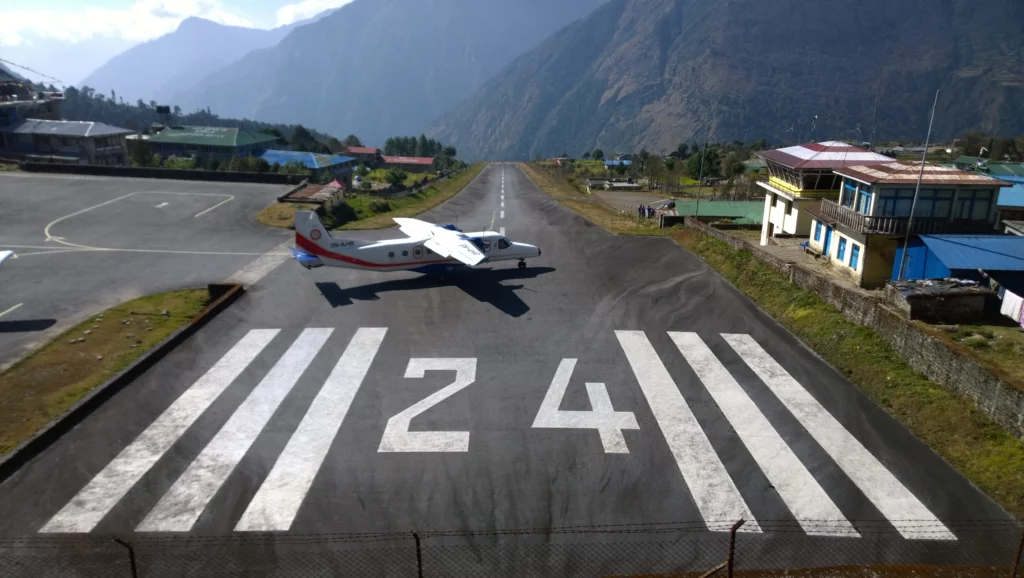
With everything in mind, a trip to Everest via Lukla is an unforgettable experience filled with breathtaking sights and memorable moments. From the scenic drive to Manthali and the awe-inspiring flight to navigating the weather, every part of the journey adds to the magic of your Everest adventure.
Alternative Transportation Options
Additionally, there are other ways to get to the Everest region. While these options might take longer, they can add an interesting twist to your adventure:
1. Drive to Tham Danda (The closest to Lukla you can drive): One alternative is a Drive to Tham Danda and trek from Tham Danda to Lukla/Phakding. You can take a jeep ride from Kathmandu to Tham Danda, which takes about 10-12 hours. From there, it’s a 4-5 Hours trek to Lukla. This route not only offers stunning scenery but also helps with acclimatization along the way. You’ll get to experience picturesque landscapes, other small villages, and the warm hospitality of locals as you make your way to Lukla.
2. Helicopter Flights: If you have a bit of extra cash to splash and want to skip the wait, you can opt for a helicopter flight directly to Lukla from Kathmandu. While this can set you back a pretty penny, it’s faster and operates more consistently in unstable weather conditions. Plus, there’s something quite exhilarating about seeing the Himalayas from the sky!
3. Phaplu Route: You could also consider flying/driving into Phaplu airport from Kathmandu. Though less common, flights to Phaplu are typically less prone to cancellations than those to Lukla. From Phaplu, it’s a 4-5 day trek to reach Lukla. This route allows you to immerse yourself in the serene beauty of the region and provides another opportunity for acclimatization. The trek from Phaplu is a bit quieter, giving you the chance to enjoy a more tranquil journey through the foothills of the Himalayas.
Each of these alternatives adds a unique experience to your Everest adventure, providing both scenic beauty and a gradual acclimatization process to help you adjust to the higher altitudes. So, whether you prefer a rugged trek or a swift helicopter ride, there’s an option that will cater to your sense of adventure and comfort level.
Flight to and from Lukla: Your Gateway to Himalayan Adventure and Tips for a Smooth Journey
Lukla Airport Known as the gateway to the prominent trekking routes of the Himalayan region, Lukla is where your real adventure begins. The flight itself to Lukla is nothing short of thrilling. The airport, one of the most challenging landings in the world due to its short and steeply inclined runway nestled between rugged mountains, turns the journey into an unforgettable experience.
When you’re planning your return journey, it’s wise to include a buffer of a day or two. Flight delays in Lukla are pretty common, often because of unpredictable weather conditions. Such delays can easily throw a wrench into tightly scheduled plans. Trust us, you’ll thank yourself for adding those extra days. Not only will it reduce stress if flights are delayed, but it also gives you some leeway to explore more of Kathmandu/Pokhara or simply relax after your trek.
Accommodation on the Everest Three Pass Trek
Planning for the Everest Three High Passes Trek involves figuring out where to stay. This trek offers stunning views and tough trails, so it’s important to plan carefully for a comfortable experience. In the Everest region, you can choose from luxury lodges, simple tea houses, or even camping, depending on your budget and adventure style. Each option provides different amenities and adds to your trekking adventure.
Understanding the different sorts of accommodations available can make a big difference in how you experience the trek. Let’s explore these options:
Local Guest Houses or Tea Houses
Tea houses are the most common form of accommodation on the Everest Three High Passes Trek. These basic guesthouses are typically family-run, offering a unique way to experience the rich local culture and lifestyle of the Himalayas. Set against the backdrop of stunning mountain scenery, staying in a tea house allows trekkers to immerse themselves in the daily lives of the Nepali people.
They are also readily available at almost every major stop along the trek, and provide the essential comforts a trekker needs, such as a warm bed, hearty meals, and a welcoming atmosphere. While the accommodations are simple, they are clean and cozy, making for a comforting retreat after a long day of hiking through rugged terrain.
The home-cooked meals served at tea houses often feature traditional Nepali dishes, allowing you to savor authentic flavors and ingredients sourced from nearby farms. Sharing a meal with fellow trekkers and the host family around a fireplace creates a sense of community and camaraderie, making your journey all the more memorable.
Furthermore, staying in tea houses supports the local economy and helps sustain the communities that live in these remote areas. The interactions with the host families offer valuable insights into their customs, traditions, and way of life. Embracing this hospitality not only enriches your trekking experience but also fosters cultural exchange and understanding.
Overall, tea houses are more than just a place to rest; they are a gateway to experiencing the warmth and resilience of the people who call these mountains home.
Amenities Provided:
Tea houses usually offer simple, clean rooms with twin beds. Bedding and blankets are provided, but it’s advisable to bring your own sleeping bag for added warmth. Shared bathrooms with squat toilets are the norm, and hot showers, when available, usually come at an extra cost. Most tea houses have a communal dining area where trekkers can enjoy hearty meals like dal bhat, momos, and Tibetan bread. A basic Wi-Fi connection can often be found, but it may not always be reliable.
Luxury Lodges
Luxury lodges in the Everest region elevate the trekking experience to another level, making it an adventure to remember. These lodges offer an oasis of comfort amidst the rugged terrain, often run by well-established chains such as Yeti Mountain Homes or Everest Summit Lodges. Nestled in key villages like Lukla, Namche Bazaar, and Phakding, they serve as perfect pit stops to rest and rejuvenate after a long day of trekking.
Imagine returning from a day of challenging hikes to a cozy lodge where warm hospitality and luxurious amenities await you. The lodges are thoughtfully designed to blend modern comforts with the natural beauty of the Himalayas. Rooms often feature heated blankets, hot showers, and stunning views of snowy peaks, offering a stark yet delightful contrast to the wilderness outside.
Moreover, these lodges provide more than just a comfortable bed. Many have in-house restaurants serving delicious meals that cater to both local and international tastes, ensuring you’re well-fed and ready for the next leg of your journey. Some even offer wellness services like massages and yoga sessions to help you relax and recover.
Staying in these lodges enriches the trekking experience, allowing you to enjoy the breathtaking beauty of the Everest region without sacrificing comfort. Whether you’re a seasoned trekker or a first-time visitor, these luxury lodges ensure that your adventure is as relaxing as it is invigorating.
Note: If you want to stay in luxury lodges, you’ll need to upgrade your package itinerary. Our trekking company, Namaste Nepal, can handle everything and make sure all your needs are met. We can totally rearrange things for you!
When you book with us, we handle everything—from luxury lodges to guided Everest tours. Ready to explore Everest in style? Tell us your preferences, and we’ll take care of the rest. Contact Namaste Nepal to start planning your dream trek!
Amenities Provided:
Luxury lodges go above and beyond to ensure comfort. You can expect cozy, well-furnished rooms with attached bathrooms, hot showers, and sometimes even a fireplace to warm your evenings. Some lodges offer Wi-Fi and satellite TV, and you might also find spa services and massage options to soothe tired muscles. The dining experience is also a notch above, with a variety of local and international cuisine served in well-decorated dining halls.
Choose What Fits Your Adventure Style
Choosing the right accommodation on the Everest 3 High Passes Trek can significantly impact your overall trekking experience. Whether you’re looking for the plush comfort of luxury lodges or the authentic experience of tea houses, there’s something for every kind of trekker. Camping and standard lodges offer additional options for those seeking unique experiences or more middle-ground comforts. Evaluate your priorities and select accommodations that match your adventure style, making your trek to the Everest region a memorable one!
Food Available on the Everest 3 Pass Trek
When you’re tackling the Everest 3 Pass Trek, good food is a crucial part of fueling your adventure. You might be wondering what kinds of meals you can expect while traversing along those breathtaking Himalayan trails. Here’s a detailed look at what you can anticipate for breakfast, lunch, dinner, and drinks along the way.
Breakfast
For breakfast, you’ll start your day on the trek in Everest 3 Pass with a variety of nourishing options to give you the energy needed for the demanding trek ahead. A typical morning meal might include staples like porridge, often made with oats or millet, which provides a warm, hearty start. You might also find Tibetan bread, a delicious and slightly sweet flatbread that pairs perfectly with butter, jam, or honey.
Eggs, cooked to your preference – whether boiled, scrambled or as an omelet – are commonly available and provide a good source of protein. You’ll likely come across pancakes, sometimes seasoned with cinnamon or served with a drizzle of local honey. For those who prefer a lighter option, there’s usually an assortment of fresh fruits, though the selection can be limited given the remote locations.
At the end of the day, you can count on enjoying a cup of tea, which can range from black to green, and even traditional Tibetan butter tea, which is unique and worth a try at least once. Coffee is also generally available, often instant but enough to give you that morning kick. Hot chocolate or lemon ginger tea can offer a comforting alternative, especially on those particularly chilly Himalayan mornings.
Meal Options:
Porridge: A warm bowl of oatmeal is a common option. It’s heartwarming and quintessentially comforting, giving you those much-needed morning carbs.
Eggs: Whether you prefer them scrambled, boiled, or made into an omelet, eggs are a protein-packed start to your day.
Pancakes: Often served with honey or jam, these fluffy delights can bring a sense of home even halfway up a mountain.
Tibetan Bread: This fried bread is similar to a thick pancake and can be enjoyed solo or with a spread.
Overall, breakfast on the Everest 3 High Passes Trek is designed to be a warming and invigorating start to your day, with plenty of options to suit varying tastes and energy needs, ensuring you’re ready to take on the trails ahead.
Lunch
Lunch on the Everest 3 Pass Trek is just as nourishing and delicious. Typically, you’ll enjoy a hearty meal at one of the charming teahouses along the trail. These welcoming spots often serve a variety of dishes, ranging from traditional Nepali cuisine like Daal Bhat (a comforting dish of lentils, rice, and vegetable curry) to more familiar Western meals, such as pasta, soups, and sandwiches.
The portions are generous, perfect for hikers in need of refueling. Many teahouses also offer fresh baked goods, so you can indulge in a treat to keep your spirits high. And of course, there are plenty of options for vegetarians and those with specific dietary needs.
After a restful and replenishing lunch, you’re set to continue your adventure with renewed energy, navigating the breathtaking landscapes and high passes that make this trek truly remarkable.
Meal Options:
Dal Bhat: The staple meal of lentil soup served with rice is an all-you-can-eat option, perfect for trekkers needing the energy to continue their journey.
Momos: These steamed dumplings are often stuffed with vegetables or meat and served with a tangy dipping sauce.
Fried Rice: A plate of flavorful rice mixed with fresh, local vegetables can be both filling and delicious.
Thukpa: A hearty noodle soup loaded with veggies and sometimes meat. It’s a warming dish ideal for chilly mountain conditions.
Sandwiches: Simple but effective, a sandwich with local cheese, meat, or vegetables can be an on-the-go option.
Eating well is an essential part of the Everest 3 High Passes Trek experience, ensuring that you have the strength and energy needed to tackle one of the most challenging and rewarding adventures in the Himalayas. The food not only sustains you but also adds to the memorable cultural experience, making each meal a part of your epic journey.
Dinner
Dinner on the trail is an opportunity to wind down after a day of exploration. Dinner usually features similar options to lunch with the added benefit of a cozy atmosphere as trekkers gather around the communal dining area, sharing stories and building camaraderie. Hot meals and warm drinks are particularly welcome as the temperatures drop in the evening, and the comfort of a filling dinner helps to ensure a good night’s sleep, critical for the days of trekking ahead.
Remember, the shared dining experience is an opportunity to bond with fellow trekkers, share stories, and soak in the serene mountain atmosphere. Enjoying these meals together can create some of the most cherished memories of your trek.
Each meal serves as both a source of strength for your body and a window into the rich, local culture, making your trek truly unforgettable.
Dinner often marks a comforting end to a day of trekking. Many tea houses and lodges along the Everest 3 High Passes Trek offer a mix of local and international dishes to cater to diverse palates. Here are some common dinner options:
Meal Options:
Curry: A variety of curries, often vegetable-based but sometimes incorporating chicken or beef, are served with rice or bread.
Pizza: Believe it or not, some lodges offer their take on pizza, giving a surprising and comforting end to a day of trekking.
Spaghetti / Pasta: Another Western staple, spaghetti is often on the menu, usually served with a basic tomato sauce or a hearty meat option.
Sherpa Stew (Syakpa): Rich and robust, this stew is made with rice, lentils, potatoes, and sometimes meat – perfect for restoring your strength.
Chapati with Vegetable Stir-fry: A flatbread paired with a mix of sautéed vegetables, it’s delicious and filled with nutrients.
Drinks
Drinks are also important to help you stay hydrated and warm, especially in the colder mountain climates. Here are some popular options you might come across:
Drinks play a crucial role in keeping you hydrated and warm, which becomes even more essential in the chilly mountain climates. Staying hydrated ensures your body can function properly at higher altitudes, while a warm beverage can provide much-needed comfort against the cold.
Drink Options:
Tea: A staple drink in the Himalayas, you’ll find a variety of teas ranging from the traditional Nepali Chiya (a spiced milk tea) to green tea. Ginger lemon tea is particularly popular and excellent for warming you up and soothing any signs of altitude sickness.
Masala Tea: This spiced tea can warm you up from the inside out and provide a delightful combination of flavors.
Hot Lemon: A soothing drink, often with honey and ginger, that’s perfect for those cold evenings and helps with altitude issues.
Black Tea: Simple yet effective, black tea can be your go-to option for quick hydration.
Yak Butter Tea: A traditional Tibetan drink, it’s made from tea leaves, yak butter, and salt. It’s definitely an acquired taste!
Fresh Water: Remember, you’ll need to drink lots of water to stay hydrated. Carry purification tablets or a filtered water bottle for safety.
Rakshi: This traditional Nepali wine is made from millet or rice. It’s often enjoyed during festivals and celebrations. Rakshi has a unique potent taste that’s worth trying.
Snacks and Small Bites:
Sukuti: Dried, seasoned meat, usually Yak and buffalo, that is chewy and packed with flavor. It’s a great source of protein and a popular snack among locals.
Gundruk: Fermented leafy greens that are dried and often used in soups or as a side dish. It’s a traditional food with a distinctive tangy flavor and is rich in probiotics.
Chhurpi: A hard cheese made from yak or cow milk, it’s chewy and offers a long-lasting snack option that’s perfect for hikes. It comes in various forms, from soft to very hard, sometimes compared to chewing gum in texture.
Exploring Himalayan food is an adventure in itself. Each dish and drink carries a piece of the region’s culture and history, offering a warm welcome to those who venture into the cold, majestic mountains.
Each meal and drink option is designed to keep you nourished and energized as you navigate those incredible high passes.
Best Time for 3 Pass Trek
The Everest 3 Pass Trek is basically the ultimate dream for trekkers in Nepal. Timing is everything, though, and picking the right season can turn your trek into an unforgettable adventure. Let’s break it down season by seasons.
Spring (March to May)
Spring is one of the most popular times to trek the Everest 3 High Passes. The weather is starting to warm up, and the mountains are at their most stunning. During March, temperatures range from -6°C to 10°C (21°F to 50°F), gradually warming up to 0°C to 15°C (32°F to 59°F) by May.

The days are getting longer, which means more daylight to savor those jaw-dropping views. The skies are generally clear, showcasing the dazzling peaks without much fog or cloud cover. Plus, the colorful blooms of rhododendrons and other wildflowers add an extra splash of beauty to the trails.
Summer (June to August)
Summer is monsoon season in Nepal, and it’s pretty much a mixed bag for trekkers. Temperatures hover between 10°C and 20°C (50°F to 68°F), so it’s milder than other times of the year. However, with the warmth comes the rain.
Expect frequent showers and an increase in humidity, which can make the trails slippery and challenging. Plus, the clouds may block those epic mountain views you’re craving. On the flip side, if you’re into lush, green landscapes and don’t mind a bit of rain, summer can offer a quieter trek since it sees fewer crowds.
Autumn (September to November)
Autumn is the rock star of trekking seasons for the Everest region. This period rivals spring in terms of popularity and is often preferred due to its stable weather conditions. Temperatures usually range from -5°C to 20°C (23°F to 68°F) as the season progresses.
Late September to November offers clear skies, making it the best window for those unbeatable panoramic mountain views. Another major bonus? The post-monsoon air is crisp and clean, meaning fewer chances of hazy horizons. Just remember, because it’s prime trekking season, the trails and teahouses can get a bit crowded.
Winter (December to February)
Winter is for the daring and adventurous. While the temperatures can drop significantly, hovering between -10°C to 10°C (14°F to 50°F) during the day and plummeting to as low as -20°C (-4°F) at night, the wintery landscape has its own kind of magic.

Think quiet, snowy trails and serene vistas, minus the hordes of trekkers. But beware: the high passes like Cho La, Renjo La, and Kongma La can be particularly challenging and may even be closed depending on snow and ice conditions. Proper gear, experience, and possibly a guide are highly recommended if you’re trekking during this season.
Choosing Your Time
So, what’s the best time to tackle the Everest 3 High Passes Trek? If you’re after ideal weather and clear skies, aim for the spring (March to May) or autumn (September to November). For those who don’t mind trading a few creature comforts for a more secluded experience, winter (December to February) offers a peaceful alternative. Unless you’re a monsoon enthusiast or looking for a quieter trail, summer (June to August) might be best avoided due to the rain and cloudy weather.
No matter when you choose to go, each season brings its own unique vibe and challenges. So, pick your time wisely and get ready for an unforgettable adventure on one of the world’s most iconic trekking routes!
Everest Three Passes Trek Booking Open for Spring 2025
Join our Everest 3 High Passes trek with Team Namaste Nepal this Spring season for an unforgettable adventure! Book with us to enjoy the blooming rhododendrons and clear mountain views, offering both excitement and beauty. Led by experienced guides, we ensure your journey is safe and memorable. Enjoy cozy accommodations and a welcoming trekking community that makes you feel at home.
Our easy booking process lets you focus on preparing for your epic adventure. Visit us at Amrit Marg Thamel, Kathmandu, Nepal, Call/WhatsApp us at +977 9843294000 or email us at [email protected] and We’ll make sure to respond swiftly and assist you with all your needs. We can’t wait to welcome you on this journey with us!
Everest Three Pass Trek Booking Open for Anthem 2025
This Autumn, grab the chance to experience our Everest Three High Passes Trek with Team Namaste Nepal. This trek is an awesome mix of challenge and stunning views, bringing you through some of the most beautiful sceneries in Nepal.
When you book with us, you get more than just a trek. You get expert guides who know the trails like the back of their hands, cozy accommodations, and a supportive trekking community that feels like family. Plus, our booking process is hassle-free, ensuring you can focus on what really matters: preparing for your adventure of a lifetime.
Feel free to drop by our office at Amrit Marg, Thamel, Kathmandu, Nepal if you’re in the area. We’re always excited to meet our clients face-to-face and discuss how we can make your trekking dreams come true. Got questions or need more info? Just reach out to us through the provided contact details. Call/WhatsApp us at +977 9843294000 or email us at [email protected] and We’ll make sure to respond swiftly and assist you with all your needs. Looking forward to connecting with you soon!
Our Trekking Team for Everest Three High Passes Trek
Experience the thrill of the Everest Three High Passes Trek with the peace of mind that comes from being in safe and experienced hands. At Namaste Nepal, we don’t just know the mountains – we’re passionate about sharing these adventures safely and memorably. Here’s why our trekking team is your best choice for this epic journey.
Meet Our Mountain Gurus: The Guides
Our trekking team is led by seasoned guides who are absolute pros in the mountains. These folks know the Everest region like the back of their hand and have an uncanny ability to anticipate every need trekkers might have along the way. But their role goes way beyond just leading you through those tough terrains. They become an integral part of your adventure, sharing in the highs and lows of the journey.
These guides have a deep-rooted knowledge of the local area, unmatched trekking skills, and a genuine love for the mountains. They help transform those challenging trails into unforgettable memories. So, whether you’re crossing a rocky path or marveling at a stunning vista, they’re right there with you, turning every moment into something special.
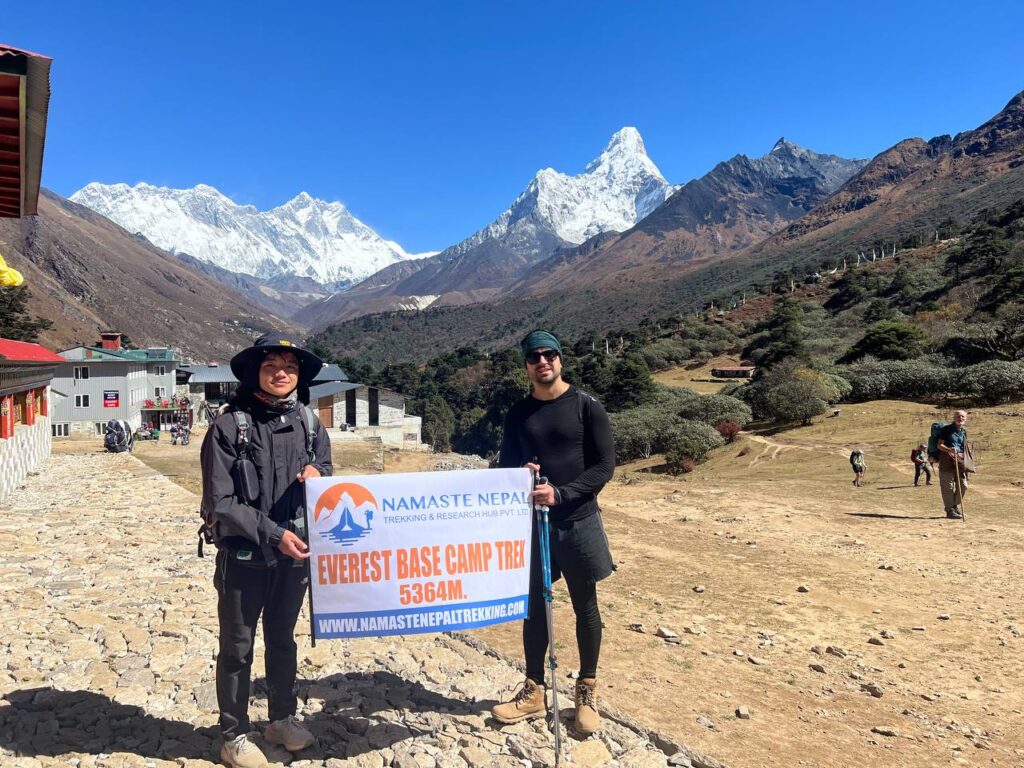
Our Porters
Our treks just wouldn’t have the same magic without our amazing porters. These folks are the real heroes of the journey, carrying most of your things so you can soak in the stunning views without a care in the world. Imagine trudging up steep, rough trails with a heavy load—well, for them, it’s like a walk in the park. Their strength is out of this world, but what’s even more impressive is their warm and friendly nature. They’re always ready to lend a hand or share a smile, truly embodying the spirit of “Namaste” that Nepal is famous for.
We take their well-being seriously because we know a happy porter means a happier trek for everyone. We make sure they’re well-treated and fairly paid. This way, they can do what they do best with a smile on their face, and you get to have an unforgettable experience. Trust us, their contribution makes all the difference!
Behind the Scenes: Our Support Staff
While our guides and porters are the face of our treks, let’s not forget the equally crucial support staff that keeps the cogs turning smoothly. Based out of our home office, our administrative team handles permits, logistics, and accommodations, ensuring everything is seamless from day one to the farewell dinner. Plus, they are always just a call away, ready to answer any pre-trek queries or post-trek reflections you might have. They’re like the pit crew that keeps our trekkers and guides fueled and focused on the adventure.
What sets our team apart is the deep local knowledge every member brings to the table. This isn’t just about knowing the shortest route or the safest path. It’s about cultural insights, hidden gems, and local legends that turn a trekking itinerary into a rich, immersive experience. Ever wondered what the prayer flags mean or the significance behind that remote monastery you just passed? Our team lives and breathes these stories and is ever willing to share them, adding layers of meaning to your trek.
Why Choose Us?
Ultimately, what makes our trekking team so special is the genuine connection they form with every trekker. It’s about more than just guiding you from point A to B; it’s about creating an atmosphere of camaraderie, respect, and shared adventure. By the end, you’ll find that you’ve not only crossed three high passes but also built lifelong friendships.
Choosing Namaste Nepal for your Everest Three High Passes Trek means you’re opting for a team that’s dedicated, experienced, and deeply passionate about everything mountain trekking. So, pack those hiking boots, prep your cameras, and get ready to embark on an awe-inspiring journey with a team that feels more like family
Safety First
While the Everest Three Passes Trek is an epic, it comes with its own set of challenges and risks. Namaste Nepal takes these very seriously. Our guides are trained in first-aid and high-altitude sickness protocols, ensuring that you’re in safe hands even in the unlikely event that something goes awry. This means they know exactly what to do if someone starts feeling unwell or facing altitude-related issues. We don’t just stop at training either. From regular health checks during the trek to always being prepared for emergencies, safety is woven into the very fabric of our treks. We make it a point to always keep an eye on your well-being, so you can focus more on soaking up the stunning scenery and less on potential worries. Our goal is to make sure that every step you take is not just thrilling but also as safe as possible.
Notable Landmarks and Viewpoints during the Everest Three Passes Trek
Taking on the Everest Three Passes Trek feels like diving into a world full of spectacular views at every corner. From standing atop high passes and staring up at massive peaks to exploring peaceful villages, this trek is packed with famous spots and amazing viewpoints. Let’s check out some of the most unforgettable places you’ll come across:
Namche Bazaar (3,440 meters)
As the gateway to the high Himalayas, Namche Bazaar is a bustling hub where trekkers can acclimatize while soaking in views of Everest and Ama Dablam. It’s the perfect blend of tradition and modernity, with charming teahouses and colorful markets.
Tengboche Monastery (3,867 meters)
A spiritual highlight of the trek, Tengboche Monastery offers panoramic views of Everest, Nuptse, Lhotse, and Ama Dablam. The serenity and spirituality of this place provide a unique contrast to the rugged terrain.
Kongma La Pass (5,528 meters)
The highest of the three passes, Kongma La offers jaw-dropping views of Makalu, the world’s fifth-highest peak. This is where trekkers truly feel the isolation and grandeur of the Himalayas.
Kala Patthar (5,545 meters)
For many, the highlight of the trek, Kala Patthar offers unparalleled close-up views of Mount Everest. Prepare for an early morning climb to catch the epic sunrise over Everest and the Khumbu Icefall.
Gokyo Ri (5,357 meters)
From the summit of Gokyo Ri, you’re rewarded with spectacular views of the turquoise Gokyo Lakes, and a panoramic vista that includes Everest, Lhotse, and Makalu. It’s a photographer’s dream come true
Chukung Ri (5,550 meters)
This trekking peak in the Khumbu region offers incredible views of Ama Dablam, Lhotse, and nearby peaks. The climb is steep but manageable for experienced trekkers, and the views at the top are worth it. It’s a great spot for those looking to explore off-the-beaten-path areas.
Renjo La Pass (5,360 meters)
One of the best high passes for panoramic views. From here, you can see Everest, Lhotse, and Makalu. The descent to Gokyo Lakes offers beautiful scenery with emerald waters and jagged peaks, perfect for photos.
Travel Insurance for Everest Three High Passes Trek
Getting travel insurance for the Everest 3 High Passes Trek is absolutely crucial. We’re talking high altitudes, remote areas, and the kind of stunning landscapes that can literally and figuratively take your breath away—sometimes a little too literally.
Make sure your insurance covers high-altitude trekking. You’ll want coverage for altitudes up to 6,000 meters, which will cover the passes you’ll be navigating. Also, look for plans that cover helicopter evacuation. Accidents happen, and altitude sickness is a real risk. If you need to be airlifted out, it’s going to cost a pretty penny, and having insurance can save you from financial ruin.
Don’t forget about general coverage, like trip cancellations, lost luggage, and medical emergencies. It’s always better to be safe than sorry, especially when you’re miles away from the nearest town or hospital.
Electricity
During your trek, you’ll generally have access to electricity at the tea houses where you’ll be staying. However, it’s not going to be like plugging in at home. Electricity mainly comes from solar panels, which means it’s limited and sometimes unreliable.
Charging your phone or camera may come with an extra cost of around $2-$5 per hour. It’s a good idea to bring a power bank or two. Also, consider using your gadgets sparingly. A solar charger is another handy option, especially for those longer, gadget-heavy days.
Drinking Water
Hydration is key, especially when you’re trekking at high altitudes. You won’t find bottled water everywhere, and where you do, it can be surprisingly expensive and environmentally unfriendly. Your best bet is to rely on purified drinking water.
Carry a good quality water purification system with you—tablets, a SteriPEN, or a reliable water filter. Tea houses often sell boiled water safe for drinking, usually costing around $1-$3 per liter. Make sure to stay hydrated but also eco-friendly!
Communication and Internet
Being disconnected can be both a blessing and a curse. While you’ll face minor connectivity issues, you can still find Wi-Fi along the route. Tea houses and lodges typically offer Wi-Fi, although it’s usually not free and can cost between $3-$5 per hour. The connection is often slow, but it’s good enough for sending a quick “I’m alive” message.
If you need reliable communication, consider getting a local SIM card. Nepal Telecom and Ncell both offer coverage, though it can be spotty in more remote regions. Better yet, stay unplugged and immerse yourself in the trek of a lifetime.
Everest Link: Best Internet Provider for the Everest Region
Planning a trek in the Everest region and need a reliable internet provider? You can count on Everest Link to keep you connected throughout your Everest Treks! This provider is specially made for trekkers, adventurers, and locals, making sure you stay connected.
With Everest Link, staying connected on your trek is easy. You can check emails, browse the web, or stay active on social media with their reliable service. You’ll always have internet access, so you won’t feel isolated as you explore the majestic peaks. Enjoy your adventure fully, knowing you can reach out
Founded in 2014, it offers high-speed internet and Wi-Fi at an altitude of 5,380 meters (17,600 feet), the highest in the world. Before Everest Link, climbers only had satellite phones. Now, even the most isolated villages in the Everest region can connect to the world.
Through projects like “Hello Doctor,” providing free online medical consultations, Everest Link addresses medical needs in areas lacking facilities. The network of 36 solar-powered towers, stretching from Lukla to Base Camp, supports these efforts.
To improve the trekking experience, Everest Link introduced the Everest Link Card. For $20, you get 10GB of data for 30 days; for $30, you get 20GB. These cards are essential for trekkers in regions like Everest, Mera, Upper Mustang, and Langtang and can be bought in Kathmandu, Lukla, Namche Bazaar, Dingboche, and more. With these cards, trekkers stay connected, sharing their adventures even in the world’s most remote destinations.
Services Offered:
Wi-Fi Connection: High-speed internet at various checkpoints and lodges.
Data Packs: Various options for different durations and needs and special rates for groups or long-term stays.
Customer Support: Online customer service for pre-trip inquiries.
For more information or to purchase a data pack, check out their official website at Everest Link – WiFi Internet. Stay connected and share every precious moment of your Everest adventure with those who matter the most!
Trip Extension: More Adventures Await
So you’ve conquered the Everest 3 High Passes Trek? While reaching new heights and soaking in those jaw-dropping views, have you thought about extending your trip to bask in more Himalayan awesomeness? Well, buckle up because we’ve got some fantastic extension options for you!
Add-On Adventure: Island Peak Climbing with Three Pass Trek
During the Everest Three High Pass Trek, Try Island Peak stands at 6,189 meters (20,305 feet). It’s perfect for trekkers wanting more height and challenge. Known for being doable for those with some mountaineering experience, it’s a great next step after completing a tough trek like Everest 3 High Passes. Though it’s considered a trekking peak, Island Peak gives you a real taste of Himalayan mountaineering with icy crevasses and steep snow slopes. The climb usually takes 3 to 5 extra days. You’ll head to the Chhukung Valley to set up base camp, prep, acclimatize, and maybe get some basic mountaineering training. The summit views are amazing, offering a panorama of Everest, Lhotse, Nuptse, and more.
Lobuche Peak Climbing with Three Pass Trk: Another Option for Peak Climbing
If Island Peak isn’t quite enough for you, or you’re craving a new adventure, check out Lobuche Peak. Standing at 6,119 meters (20,075 feet), it offers a thrilling climb with different views and a unique path. There are two options for climbing: Lobuche East and Lobuche West. Most trekkers go for Lobuche East—it’s easier but still gets your heart racing. Climbing can take an extra 2 to 4 days, starting from Lobuche Village on the Everest trek route. Like Island Peak, some mountaineering skills are helpful, but we will make sure you’re ready.
Relax and Recharge: Pokhara
If you’re in the mood for some serious relaxation, head to Pokhara—a calm lakeside town perfect for relaxation.
While you’re there, take a boat ride on Phewa Lake relax in one of the lakeside cafes with a good book or Try some light paragliding, or visit the World Peace Pagoda. There are so many activities to do in Pokhara city.
Cultural Detour: Explore Back in Kathmandu
Feeling cultural? Spend an extra few days exploring Kathmandu before or after your trek. Dive into its vibrant markets, historic temples, and mouth-watering street food. Visit Swayambhunath (the Monkey Temple) for some amazing panoramic views of the city, or stroll around the ancient squares in Bhaktapur and Patan for a trip back in time.
Tipping for your Three Pass Guide and Support Staff
Tipping is quite common and appreciated in the trekking industry in Nepal. If you’ve had a great experience, it’s a nice way to show your appreciation. For guides, tipping around $10-$15 per day is fair. Porters usually get $5-$10 per day.
You can tip them at the end of your trek, and it’s customary to hand the tip directly with a warm word of thanks. Feel free to adjust these amounts based on your satisfaction and the level of service provided.
Currency Exchange, ATMs, and Cards
Money matters can be a bit tricky in the mountains, so plan ahead. Nepalese Rupees (NPR) is the local currency, and you can easily exchange your dollars or euros at authorized exchange counters in Kathmandu. While there are ATMs in larger towns like Namche Bazaar, the higher you trek, the scarcer they become.
Most places in the trekking route prefer cash; credit cards might not be widely accepted, and if they are, there’s usually an additional administrative fee. Ensure you carry enough cash to cover your essentials like meals, hot showers, and that occasional Yak wool sweater that catches your eye.
Frequently Asked Questions
General
What is the Everest Three High Passes Trek?
Everest Three High Passes is a challenging trek, which crosses three high-altitude passes in the stunning Everest region. It’s not for the faint-hearted, with rugged trails, steep ascents, and breathtaking views that will test your limits and reward you with incredible experiences.
How long is the 3 Pass Trek?
Typically, the whole journey takes around 15 to 20 days. This timeframe includes not just the main activity or adventure, but also the days needed for acclimatization if you’re adjusting to a new altitude or environment.
When is the best time to do 3 Pass Trek?
Spring, which lasts from March to May, and Autumn, spanning from September to November, are two of the most pleasant times of the year. During Spring, flowers bloom, temperatures rise, and everything feels fresh and renewed. Autumn, on the other hand, brings a cool, crisp feeling to the air, leaves change to brilliant shades of red and orange, and it’s the perfect time to enjoy cozy sweaters and warm drinks.
What are the High Passes?
You’ll be crossing some incredible high passes such as Kongma La at 5,535 meters, Cho La at 5,420 meters, and Renjo La at 5,360 meters. Each of these passes provides unique views and memorable experiences, showcasing the diversity and beauty of the Himalayas.
What’s the highest altitude reached?
The highest point of the trek is Kala Patthar, standing at 5,545 meters. From here, you’ll get unparalleled views of Everest. This spot is often considered the highlight of the trek because of the breathtaking panorama it offers.
What’s the group size for the trek?
Group sizes typically range from 1 to 15 people. Smaller groups allow for a more personalized experience, while larger groups offer a social trekking environment.
Booking and Payment
How do I pay for the 3 Pass Trek?
Payment can be made easily through our secure online system using major credit cards. We also accept bank transfers. Further details are available on our website.
What permits are needed?
Leave it to us—it’s our job, and we love doing it!
You’ll need three main permits: a Khumbhu Pasang Lhamu Rural Municipality Entrance Permit, Sagarmatha National Park Entry Permit and TIMS Card. These permits are required for all trekkers in the region, and we can assist you in securing them before your journey begins, making the process hassle-free.
Are there ATMs on the route?
ATMs are quite limited along the trekking route, mainly found in Lukla and Namche Bazaar. It’s wise to carry enough cash for the entire trek to cover your additional expenses. We’ll help you estimate how much you’ll need to bring.
What about tipping?
Tipping your guides and porters is customary and greatly appreciated. It’s a way to acknowledge their hard work and the invaluable support they provide throughout your trek. We can guide you on the standard tipping practices to ensure fair and generous gratuity.
Do you offer any discounts or promotions?
Yes, We offer special discounts for the group, More people in your group less the cost. We periodically offer discounts and promotional deals. Check our website or subscribe to our newsletter to stay updated on the latest offers.
Physial Fitness
Is 3 Pass a difficult trek?
Absolutely, it’s a tough trek, primarily due to the high altitudes and the demanding trails. The physical exertion required is significant, making it quite a challenging adventure. However, the stunning landscapes and the sense of achievement you’ll experience at the end make every step worth it.
Do I need prior trekking experience?
While prior trekking experience is beneficial, it’s not absolutely essential. What’s most important is being physically fit and willing to push your limits. We offer comprehensive preparation tips and training plans to help you get ready, ensuring you have the best possible experience.
How should I train for the trek?
Training should include a mix of cardio and strength exercises, alongside practice hikes with a loaded pack. Focus on building endurance and muscle strength to withstand the demands of high-altitude trekking. We provide detailed training programs to get you trek-ready.
What kind of training should I do before 3 Pass trek?
Regular cardio workouts, such as running, swimming, or cycling, combined with strength training, are excellent preparations. It’s also beneficial to include some hiking practice with a loaded backpack.
Are there age restrictions for your treks?
While there’s no strict age limit, we generally recommend our treks for individuals above 10 years old and those in good health. We can tailor the trek specifics based on age and fitness levels.
Preparation for 3 Pass Trek
What gear should I bring?
Essential gear includes trekking boots, warm clothing, a good-quality sleeping bag, trekking poles, and other basics. We’ll provide you with a detailed packing list and recommend the best gear for high-altitude trekking so that you’re fully prepared for the adventure.
Can I rent gear in Kathmandu?
Yes, you can rent gear in Kathmandu, but it’s crucial that the gear is of high quality, especially for high-altitude trekking. We can recommend reliable rental shops where you can find equipment that meets the required standards.
Can I customize the trek?
Yes, we offer customizable itineraries to meet your preferences, time frame, and budget. Share your requirements with us, and we’ll design the perfect trek for you.
How do I acclimatize?
The key to acclimatization is a gradual climb, interspersed with rest days at strategically important points. Our itineraries are carefully designed with acclimatization in mind, allowing your body to adjust to the increasing altitude, which significantly reduces the risk of altitude sickness.
Is there a weight limit for baggage?
For flights to Lukla, there’s typically a weight limit of 15 kg per person. Packing smart and light is crucial. We’ll provide you with tips on how to pack efficiently for your trek, ensuring you have all the essentials without exceeding the limit.
How do we get to Lukla?
Typically, you’ll reach Lukla via a thrilling flight from Kathmandu or Manthali Airport depending on the time of the year you choose to trek. We handle all the logistics of your travel arrangements, so you can focus on enjoying the adventure from the moment your journey begins.
Can I extend my trek?
Yes, extensions such as a climb Island Peak, Climb Lobuche Peak, or a cultural tour in Kathmandu and Pokhara can be arranged. Let us know your interests, and we’ll include them in your itinerary.
Accommodation and Meals
What kind of accommodation is available?
During the Three Pass Trek, accommodation will primarily be in the Best available Guesthouses. These are basic lodges offering simple rooms, often with shared bathrooms. In Kathmandu, you’ll stay in a comfortable, selected 3-star hotel included in the package.
If you wish to upgrade the hotels in Kathmandu and some parts of the trek are available on the request.
Is hot water available?
Hot water for showers is available at many teahouses but usually comes with an extra cost. At higher altitudes, the availability of hot water may be limited, and the cost increases as you go up.
Is Wi-Fi available during the trek?
Wi-Fi is available at most teahouses for an extra charge. However, the connection may be slow and unreliable, especially at higher altitudes.
What meals are provided?
Meals during the trek are typically prepared in teahouses and include local dishes such as dal bhat (rice and lentils) and international options like pasta, noodles, and soup. Our package includes three meals a day during the trek and breakfast in Kathmandu.
Are vegetarian or special diets available?
Yes, vegetarian meals are readily available, and we can also accommodate special dietary requirements. It’s important to let us know your preferences or restrictions in advance to ensure we can cater to your needs.
Is drinking water provided?
Safe drinking water is available at teahouses or can be purchased along the route. Alternatively, you can use water purification tablets or a filtering system to treat tap or stream water. We encourage eco-friendly practices to minimize plastic waste.
Altitude and Health
What is altitude sickness?
Altitude sickness, or Acute Mountain Sickness (AMS), occurs when your body struggles to adapt to lower oxygen levels at higher altitudes. Symptoms may include headache, nausea, and fatigue.
How can I prevent altitude sickness?
Gradual ascent, proper hydration, and rest days for acclimatization are key to preventing altitude sickness. Our itineraries are carefully designed to include sufficient acclimatization time to reduce risks.
What happens if I get sick during the trek?
If you develop altitude sickness or any other illness during the trek, your guide will monitor your condition closely and decide the best course of action. This may include descending to a lower altitude or arranging evacuation if necessary.
Do I need travel insurance?
Yes, travel insurance is mandatory for this trek. It must cover high-altitude trekking and emergency evacuation, including helicopter rescue. We can assist you in selecting a suitable insurance provider.
Are there any medical facilities along the route?
Basic medical facilities are available in villages like Lukla, Namche Bazaar, and Dingboche. However, for serious conditions, evacuation to Kathmandu is necessary. Carrying a personal first aid kit is also highly recommended.
Weather and Safety
What weather conditions should I expect?
The weather can vary greatly depending on the season. Spring and Autumn offer stable and clear conditions, while winter can be extremely cold, and summer brings monsoon rains. Be prepared for sudden weather changes at high altitudes.
Is the 3 Pass Trek safe?
Yes, the trek is generally safe with experienced guides and proper preparation. Your safety is our priority, and we provide well-trained guides, proper equipment, and well-planned itineraries.
What are the risks involved?
Risks include altitude sickness, injuries due to rough terrain, and sudden weather changes. These risks are mitigated through acclimatization, proper gear, and experienced guides.
Do I need special skills or equipment?
No technical climbing skills are required, but you do need good physical fitness and appropriate trekking gear. Trekking poles, sturdy boots, and warm clothing are essential for your safety and comfort.
Is the Lukla flight safe?
The flight to Lukla is short but thrilling, with experienced pilots managing challenging conditions. While weather-related delays are common, safety standards are strictly followed.
Guide and Support Staff (Porters)
Will I have a guide?
Yes, all our treks include experienced, licensed guides who are knowledgeable about the region, culture, and safety measures.
Are porters available?
Yes, porters are available to carry your luggage, making the trek less physically demanding for you. They adhere to weight limits and ethical standards to ensure fair treatment.
What is the guide-to-client ratio?
Typically, we maintain a 1:8 guide-to-client ratio to ensure personalized attention and support during the trek. If there are more than 8 people in the group we will provide 1 Assistant trekking guide for each 5 person.
What language do the guides speak?
Our guides speak English and have excellent communication skills to help you understand the local culture, geography, and safety instructions.
Can I tip my guide and porter?
Tipping is customary and appreciated. The amount is up to your discretion, but we can provide guidance on the standard tipping rates for the region.
Tipping around $10-$15 per day for a guide is fair. For Porters $5-$10 per day is fair.
What if I have more questions?
Feel free to contact us via Email, WhatsApp, Telegram, WeChat, Line, or Instagram for any additional queries. Our team is always ready to assist you and provide detailed information.
Email: [email protected], [email protected]
Whatsapp: +977-9843294000
Teligram: +977-9843294000
WeChat: Mr. Rajan
Instagram: @amastenepaltrekking
- 1 - 1 personUS$ 2495
- 2 - 2 personUS$ 1980
- 3 - 5 personUS$ 1765
- 6 - 10 personUS$ 1695
- 11 over 9999 US$ 1600
- Your safety, our no 1 priority
- Best price guarantee
- Experienced & dedicated team
- Easy booking, no hidden charge
- You can customize this trip
US$ 2495



